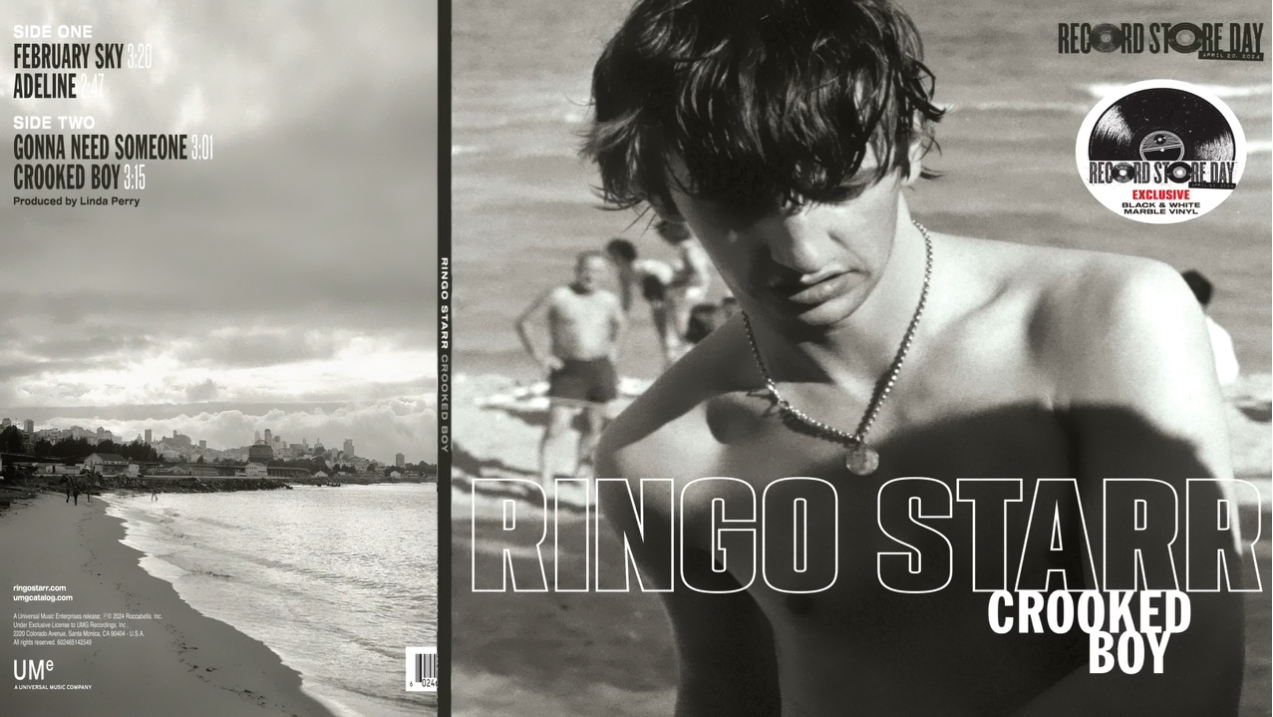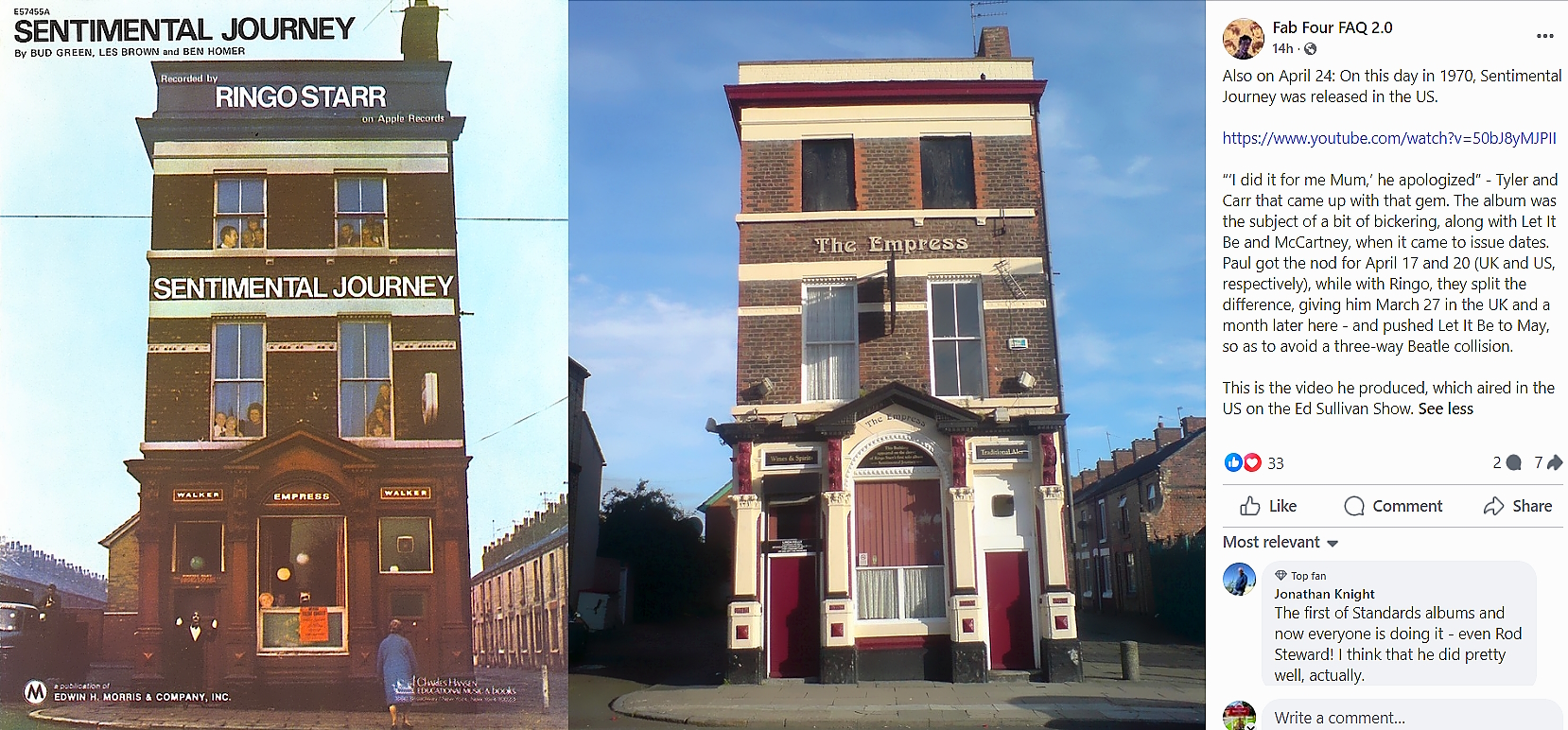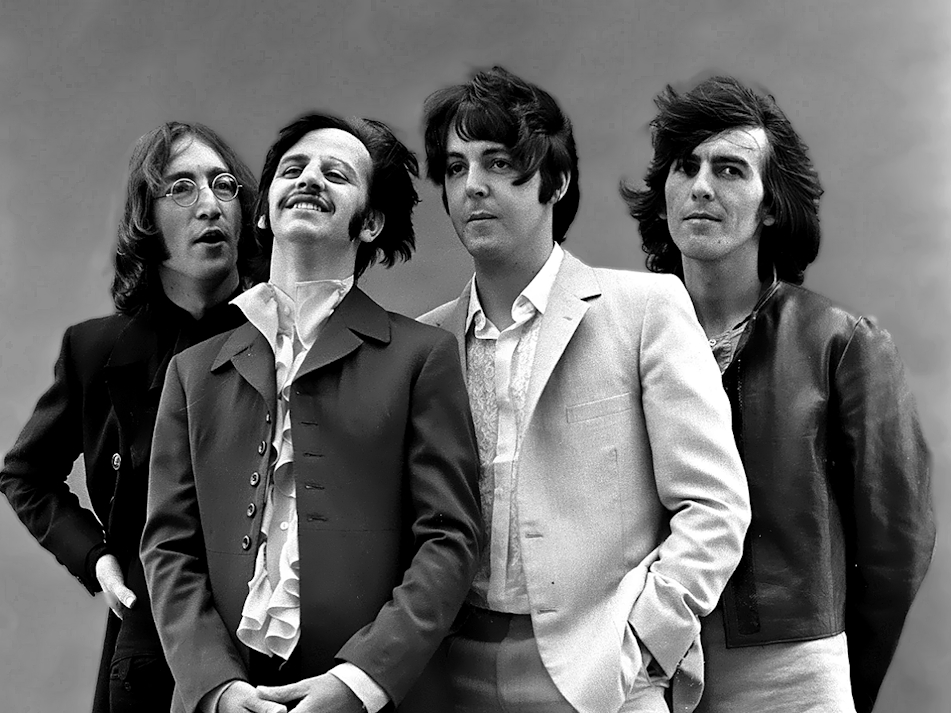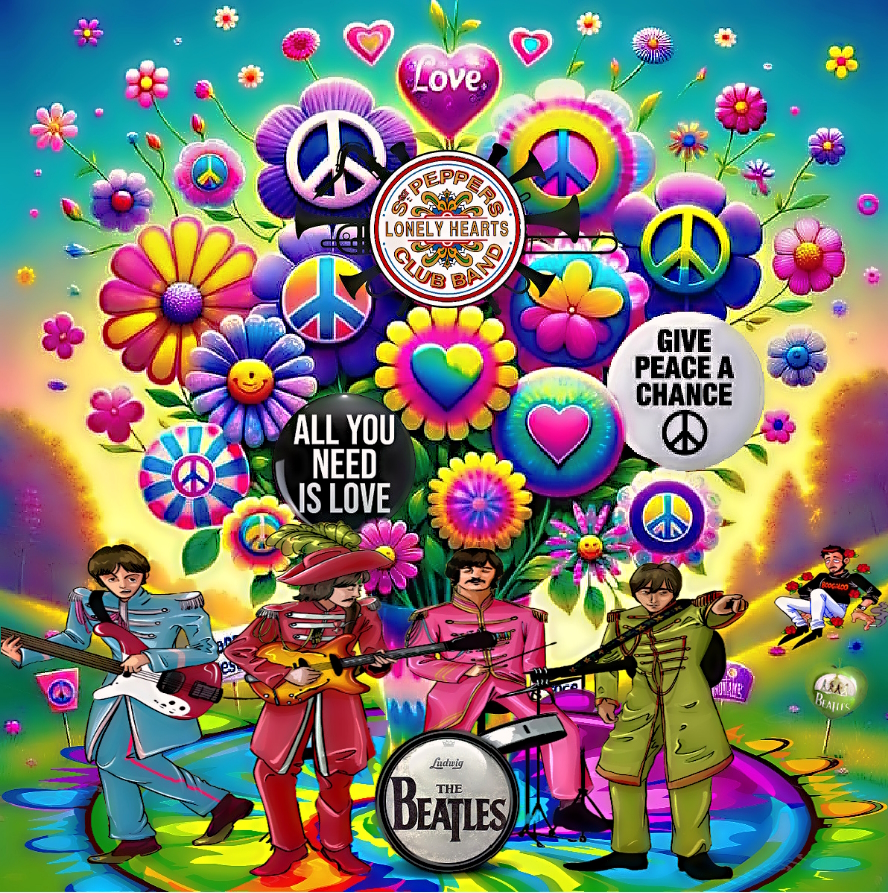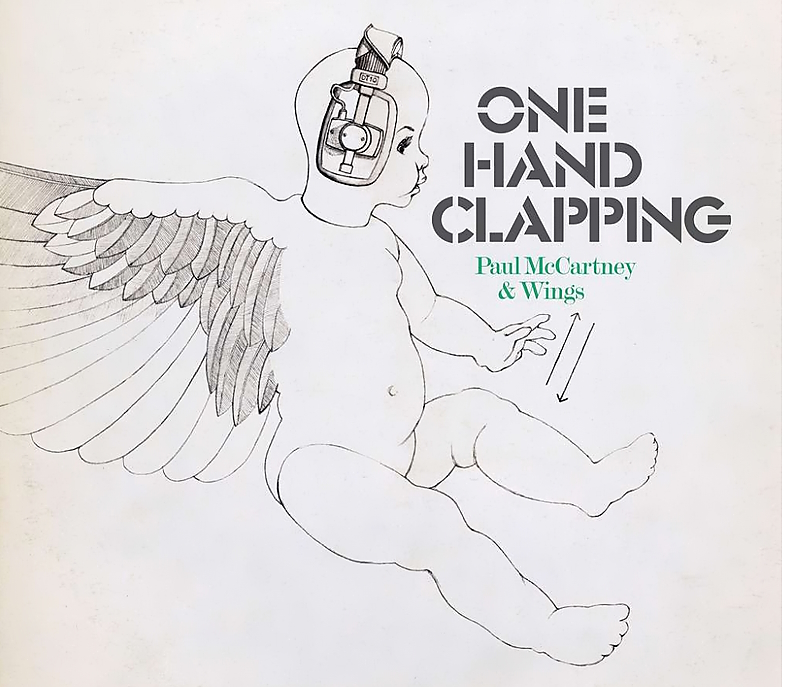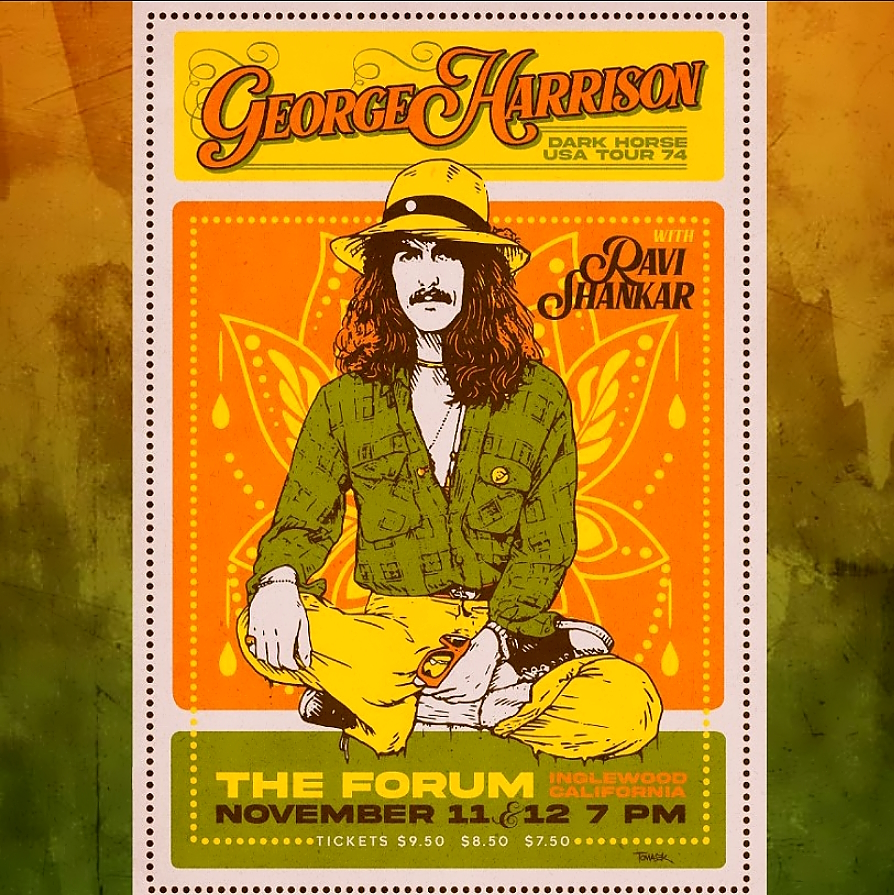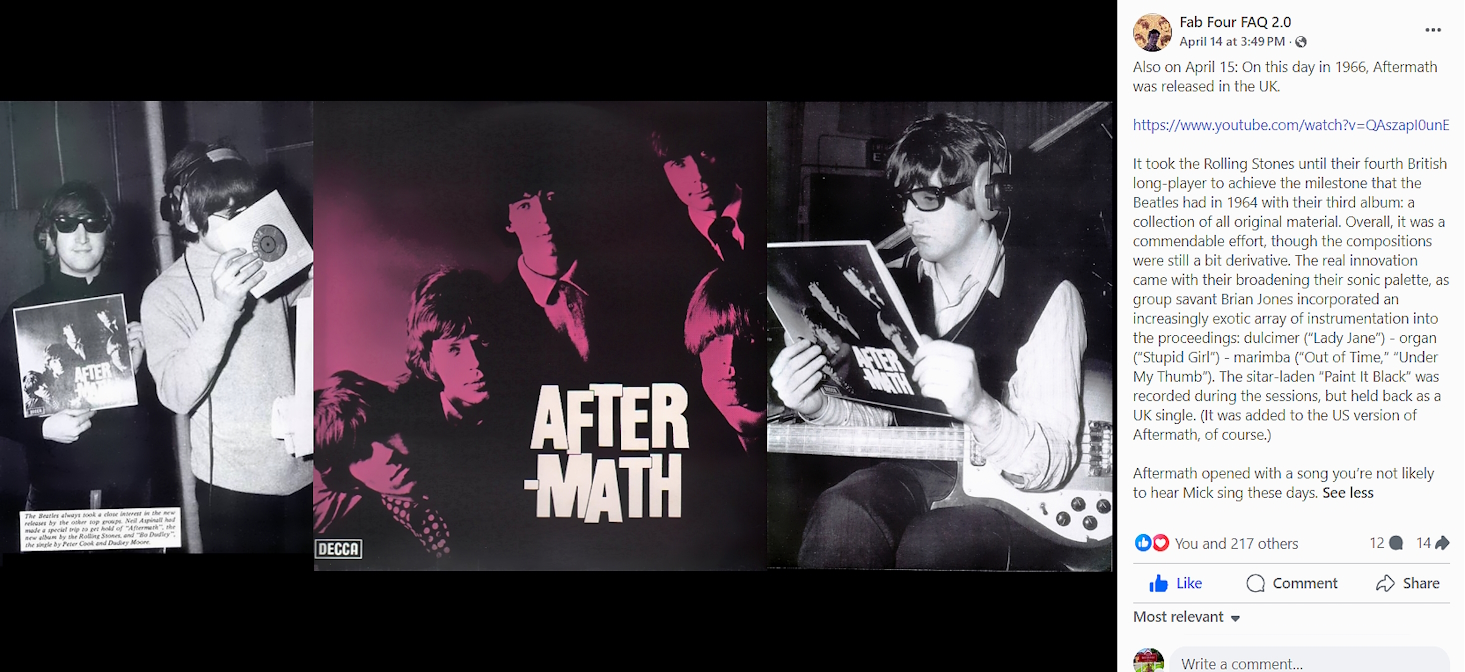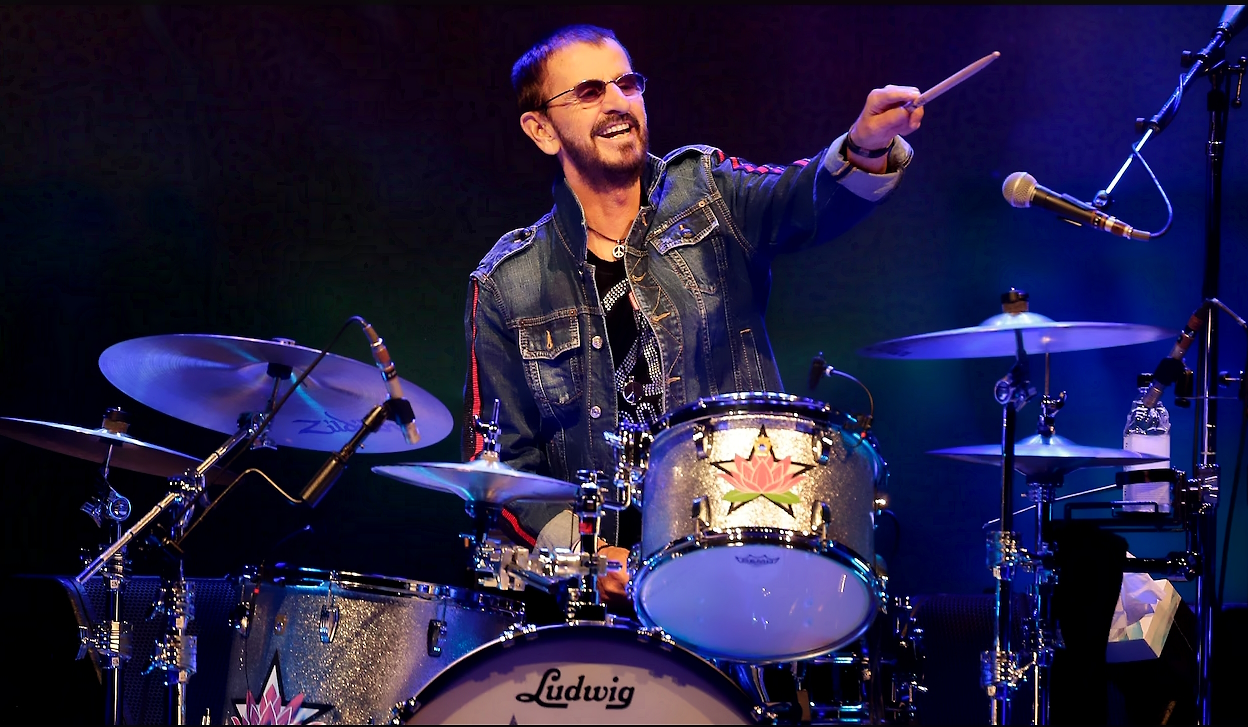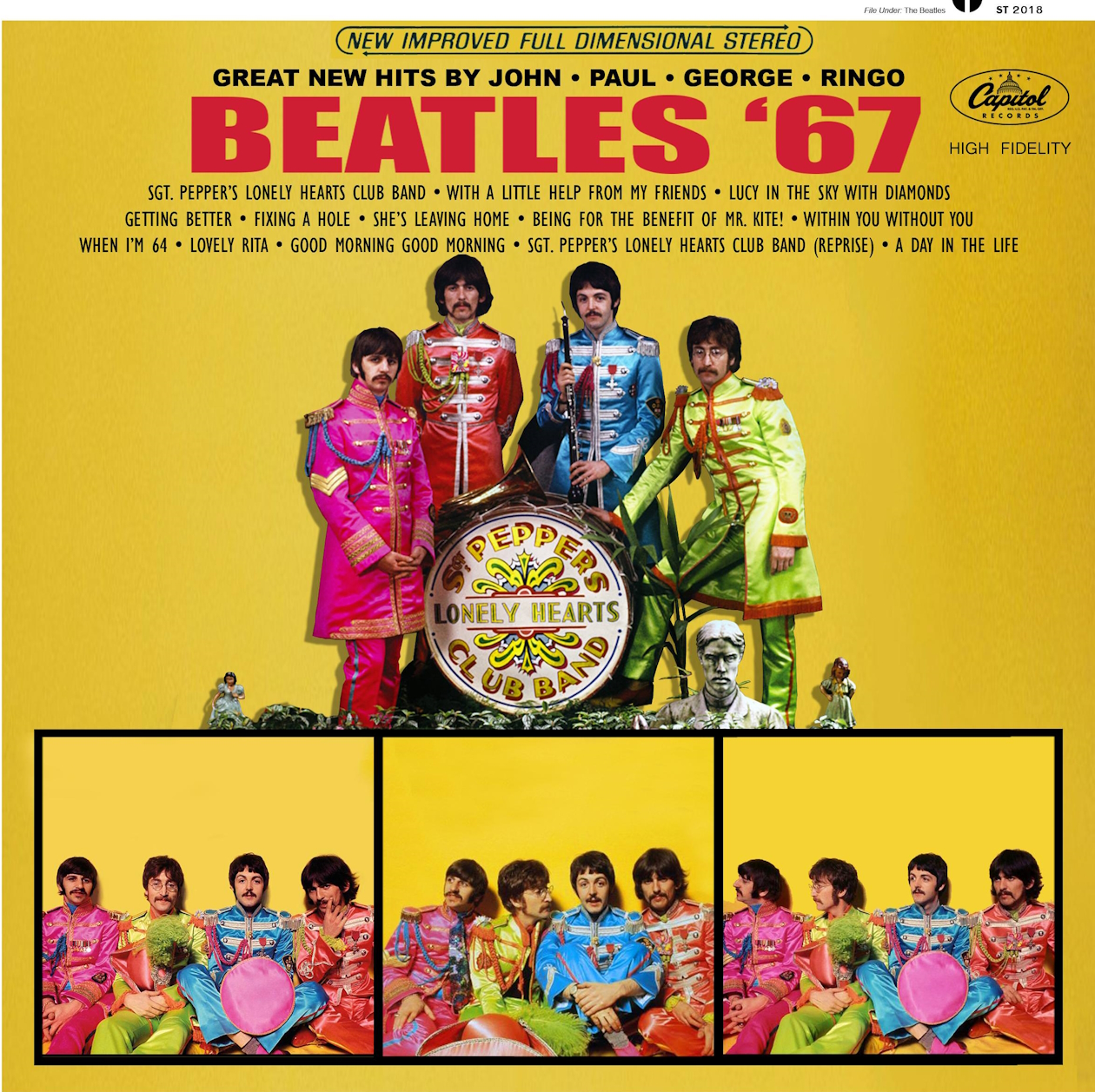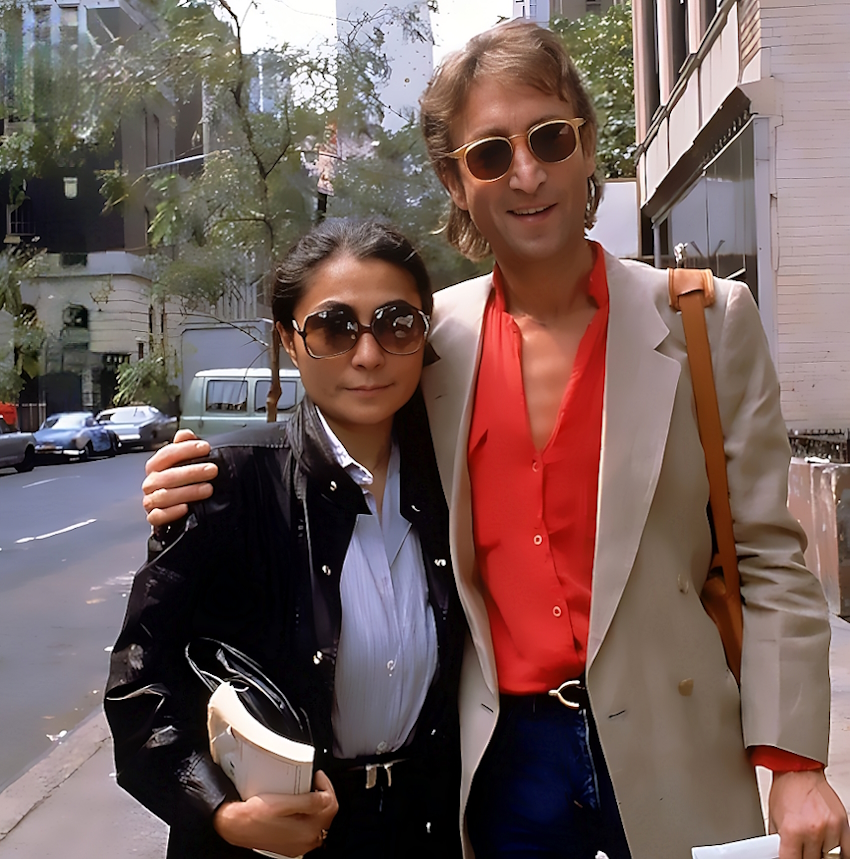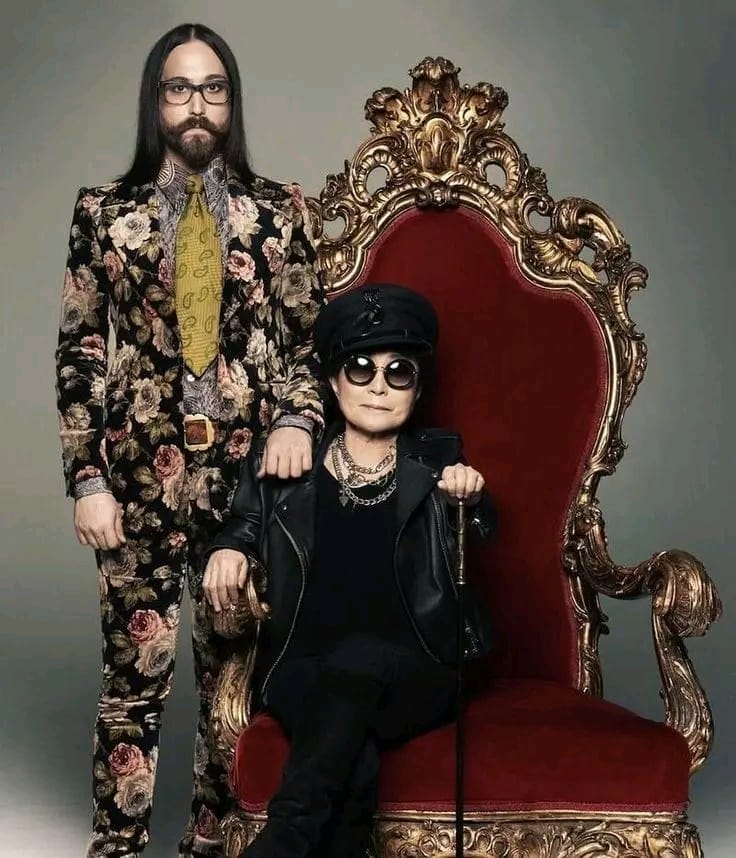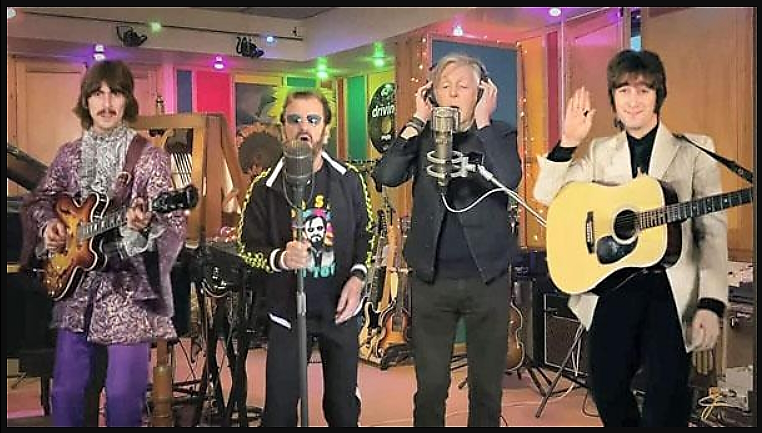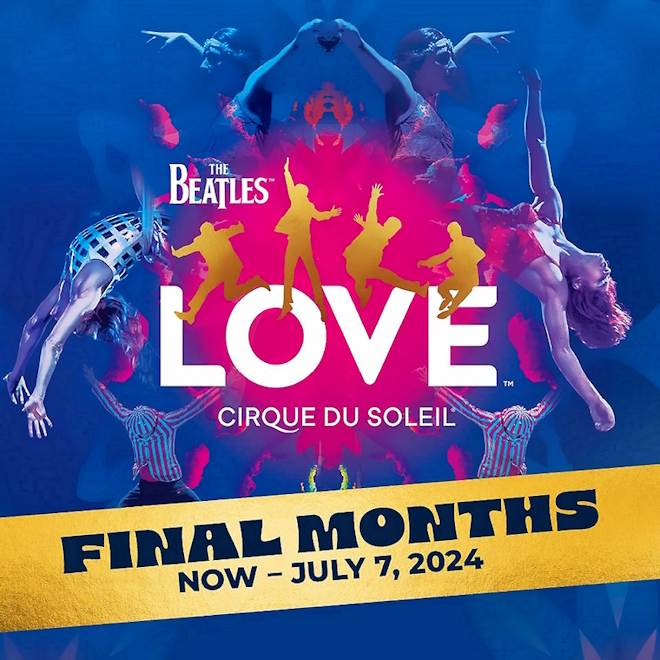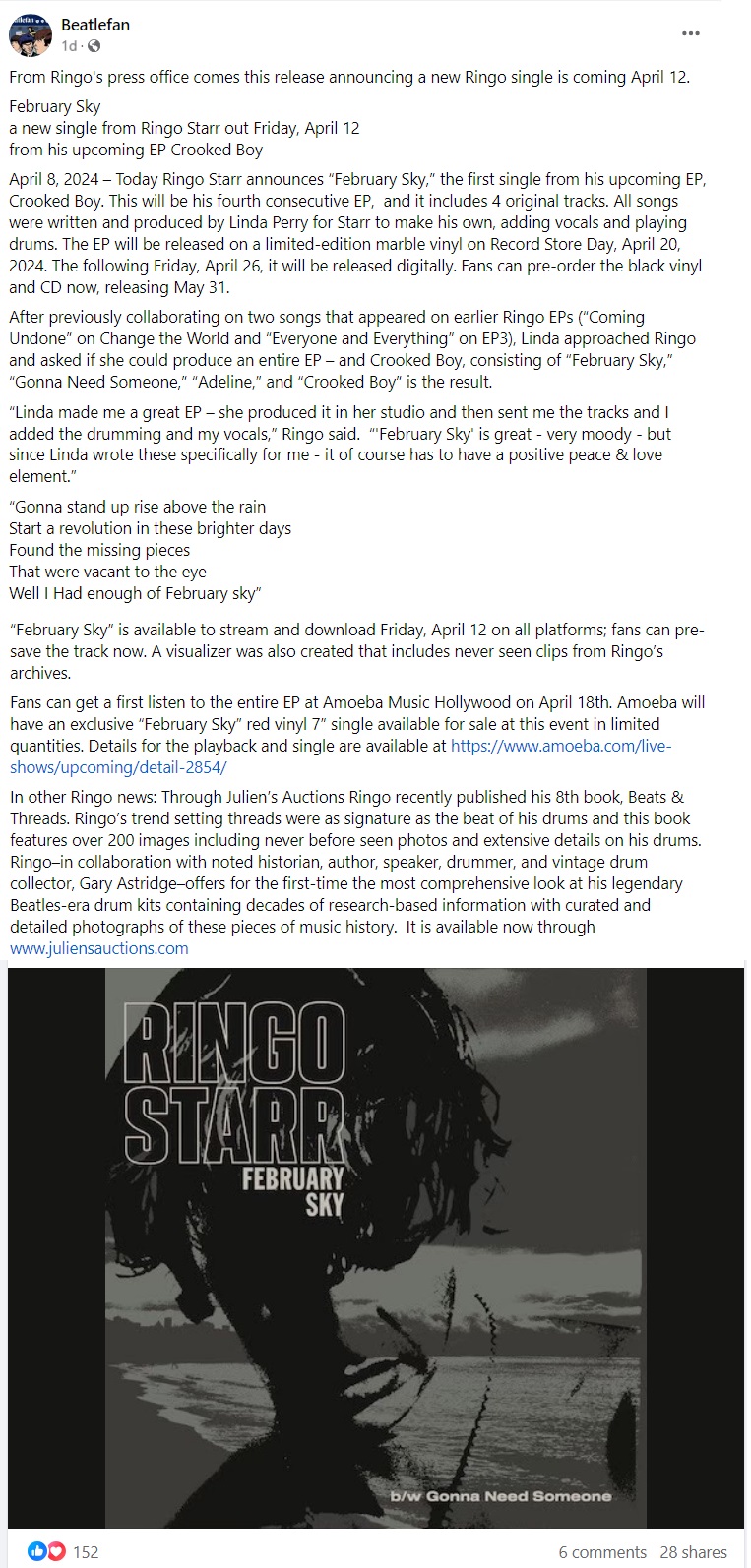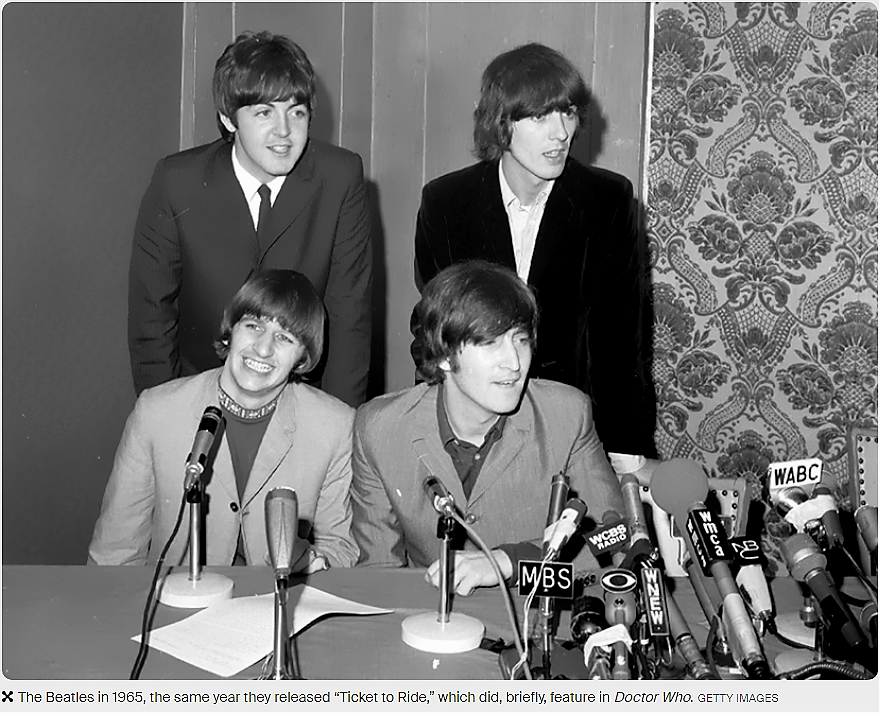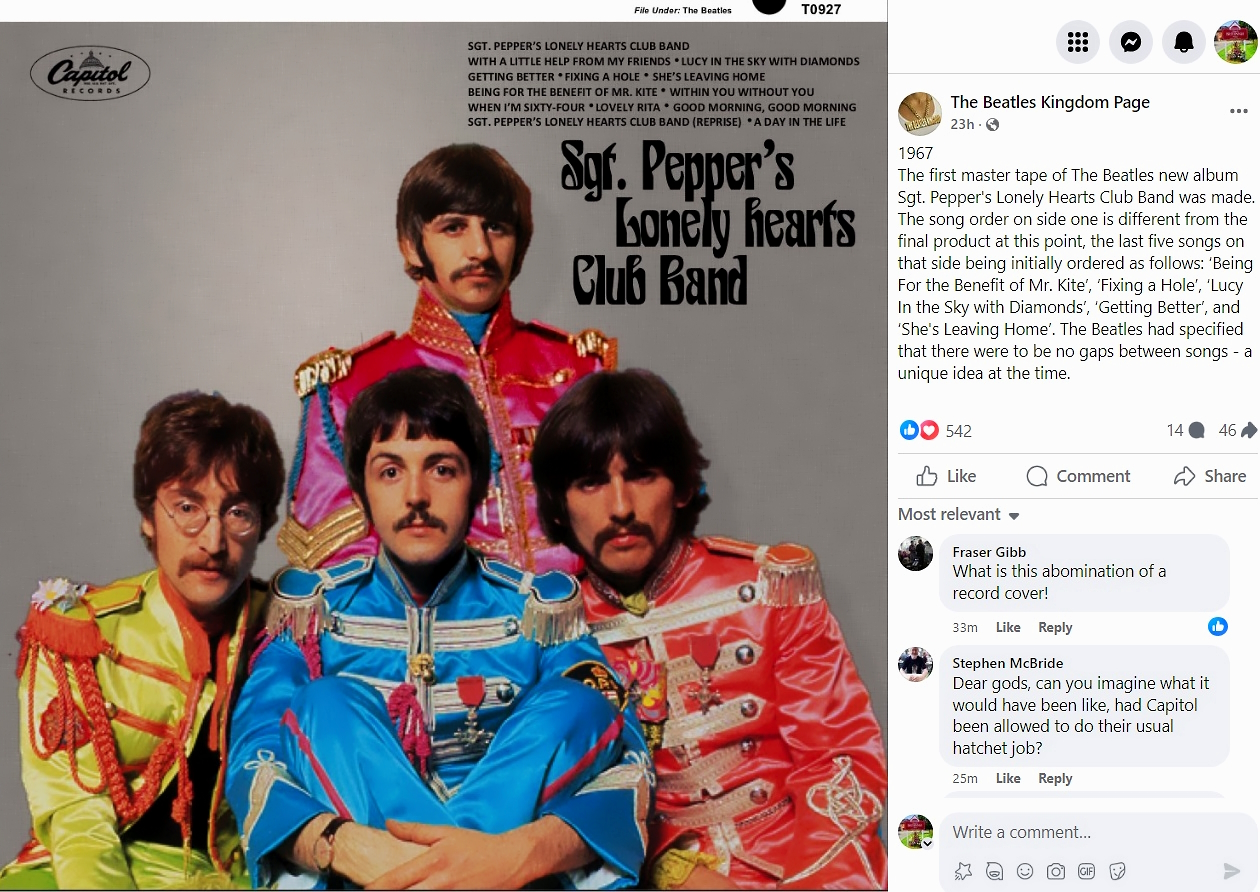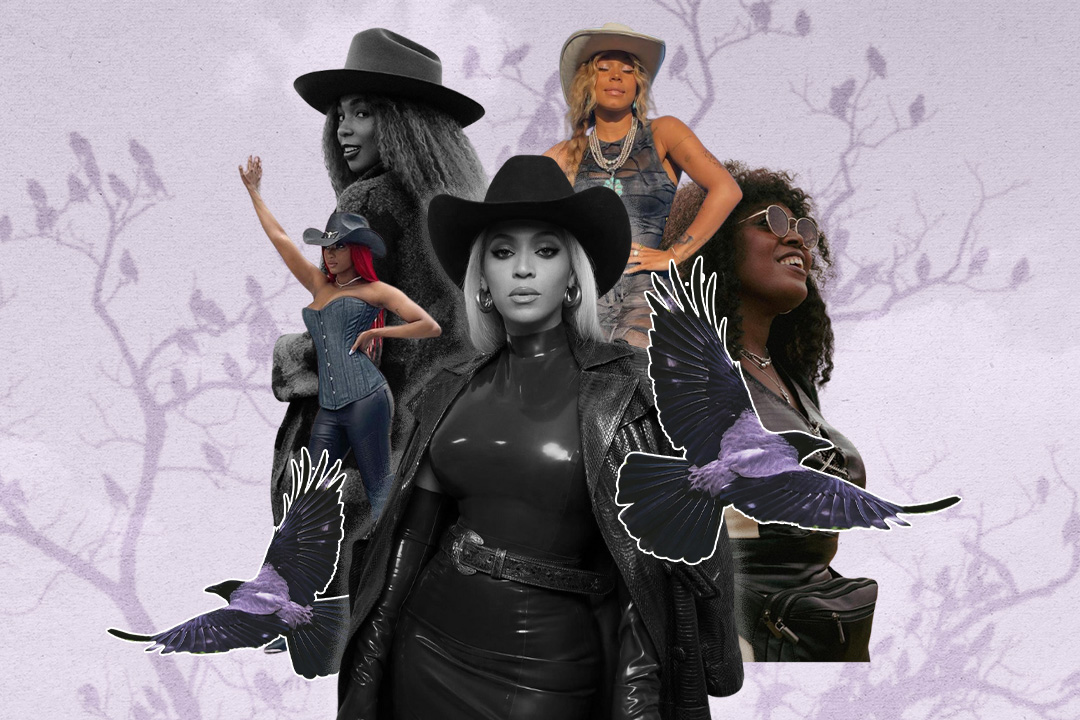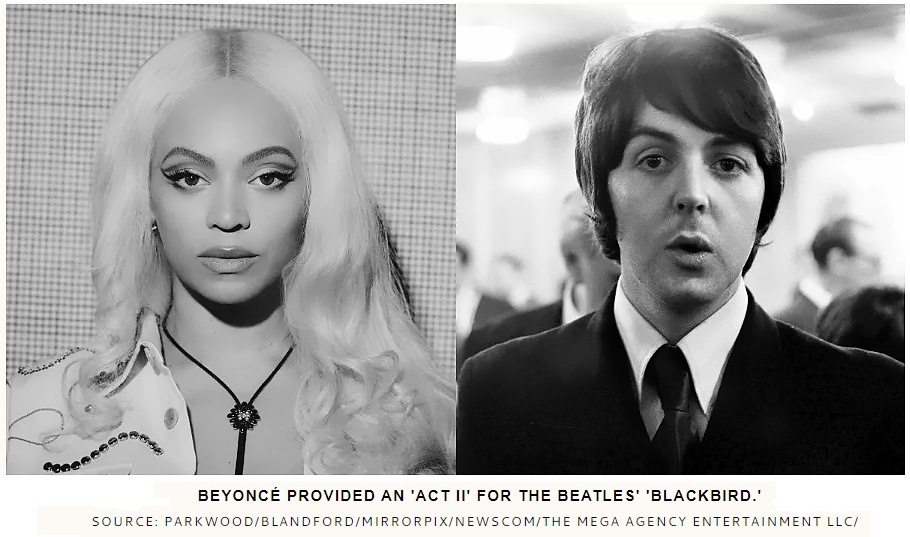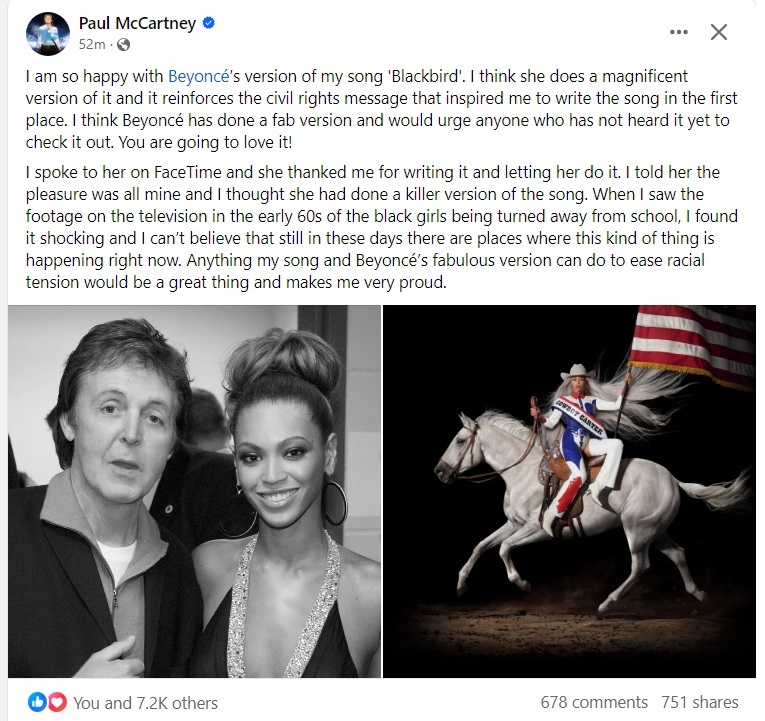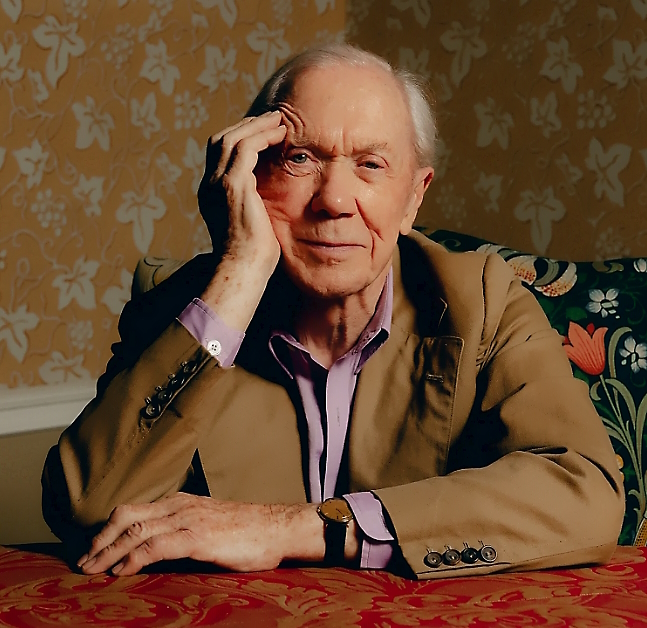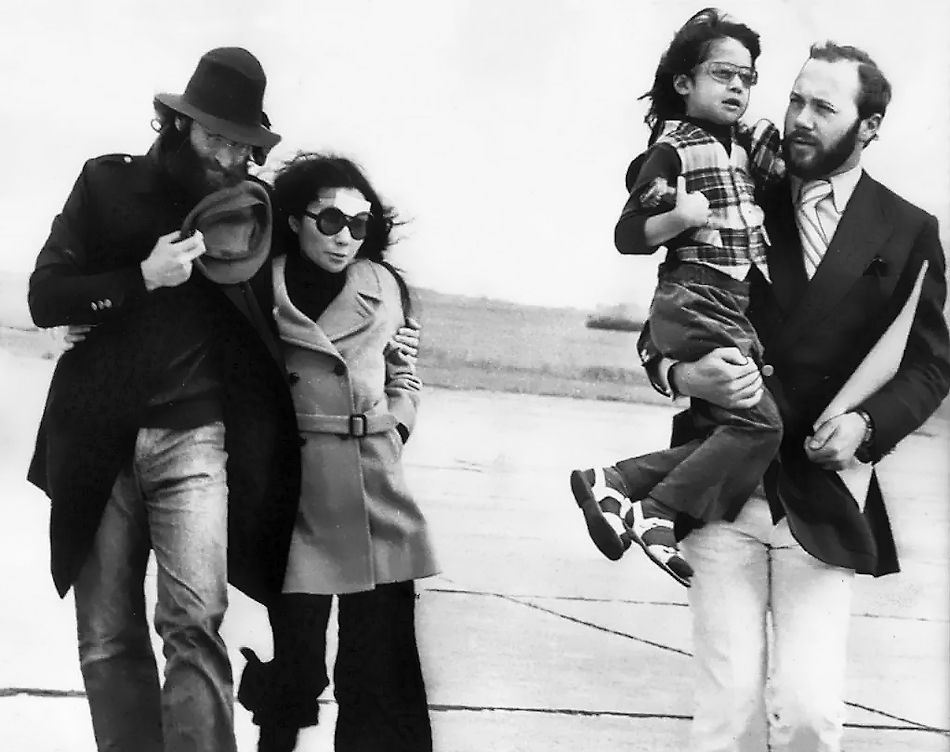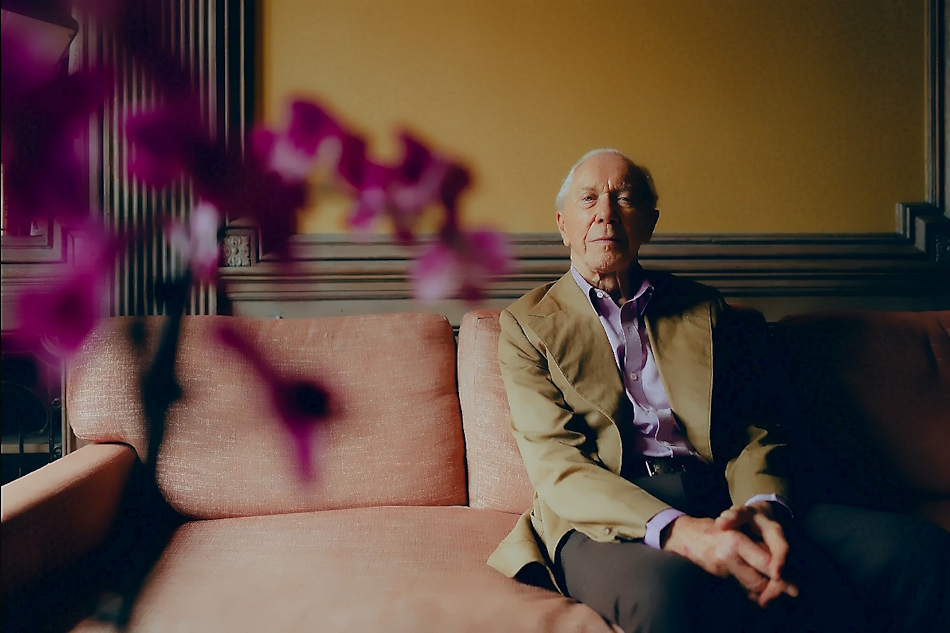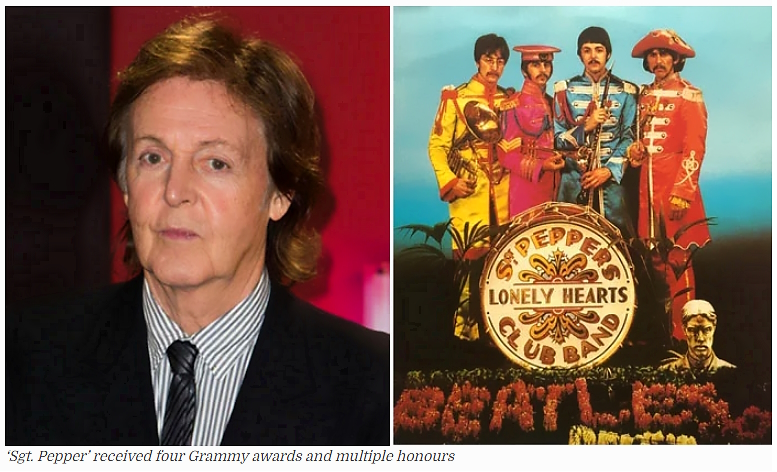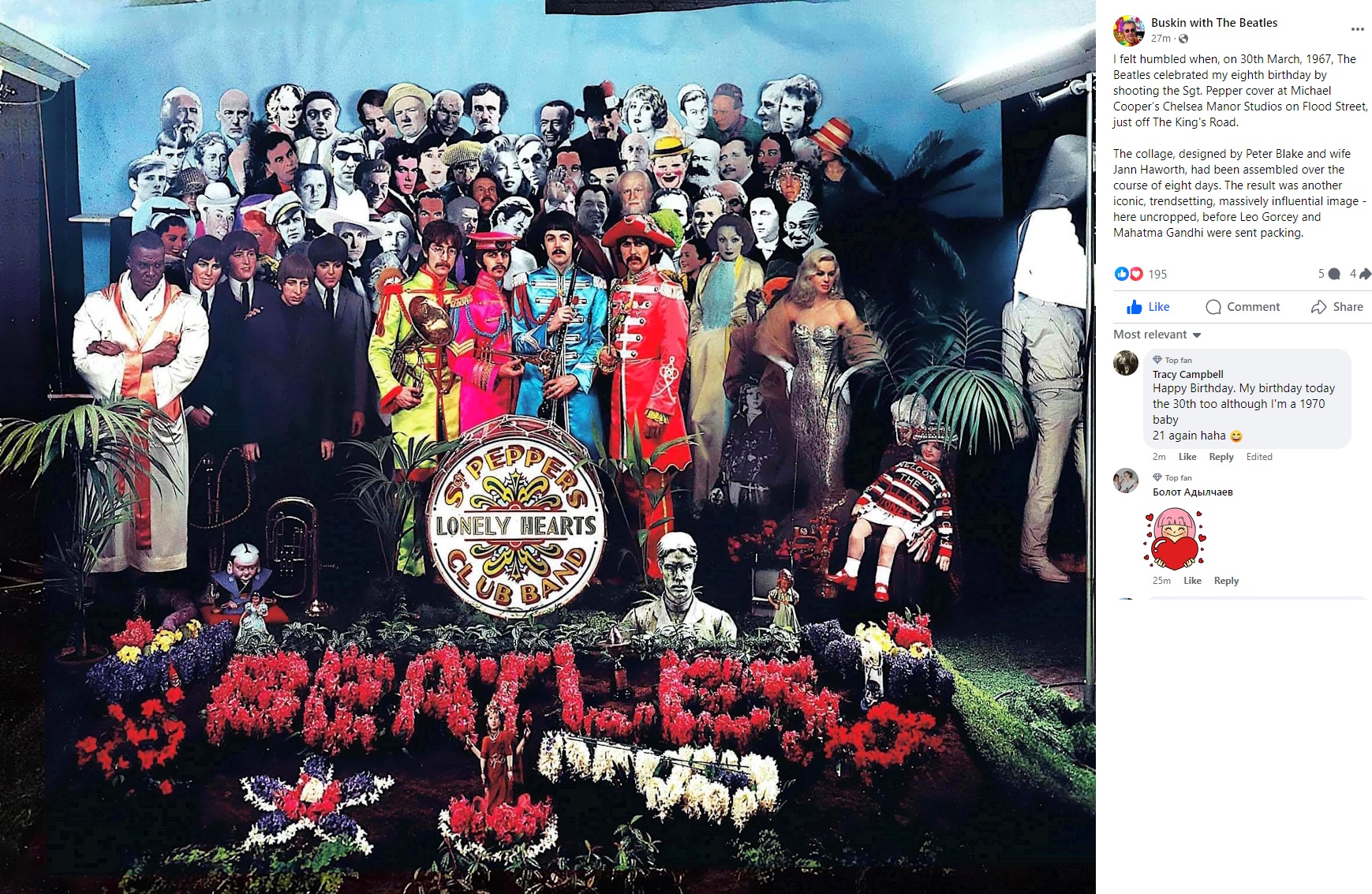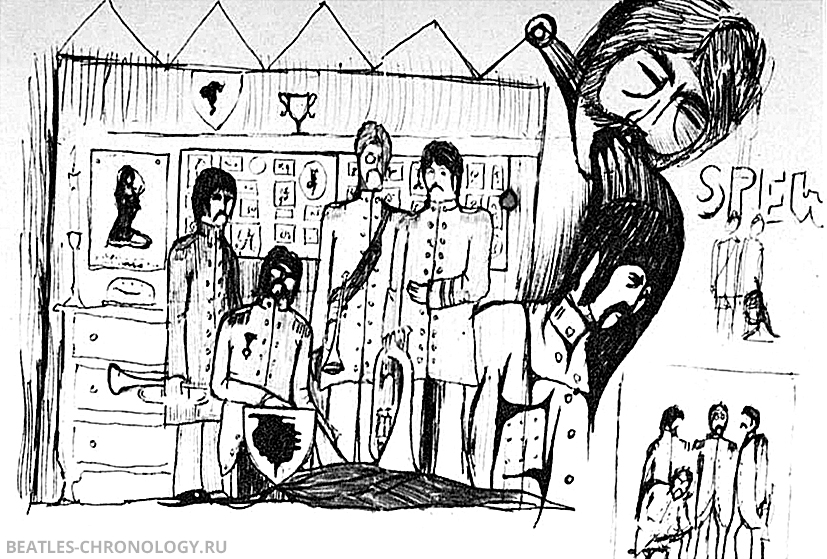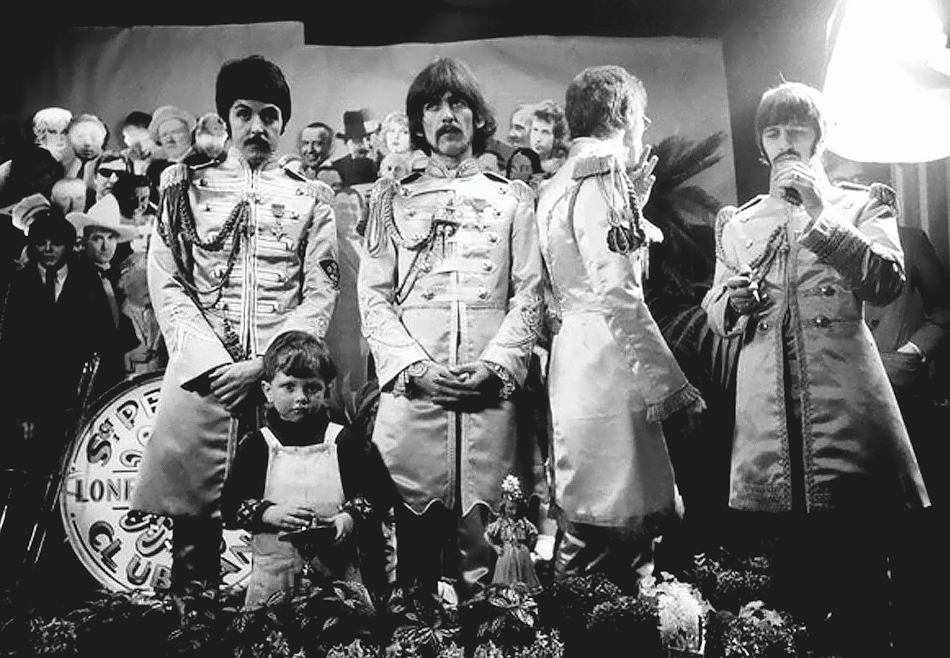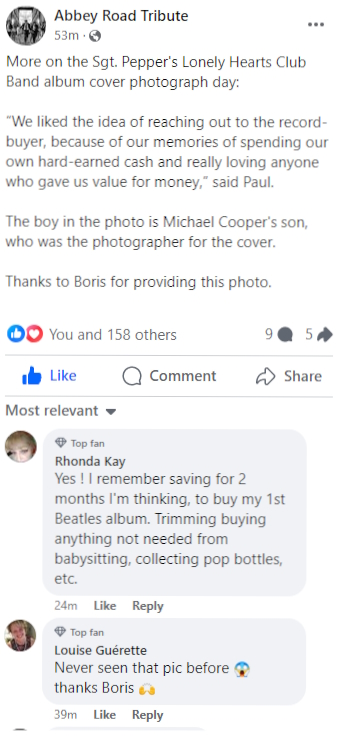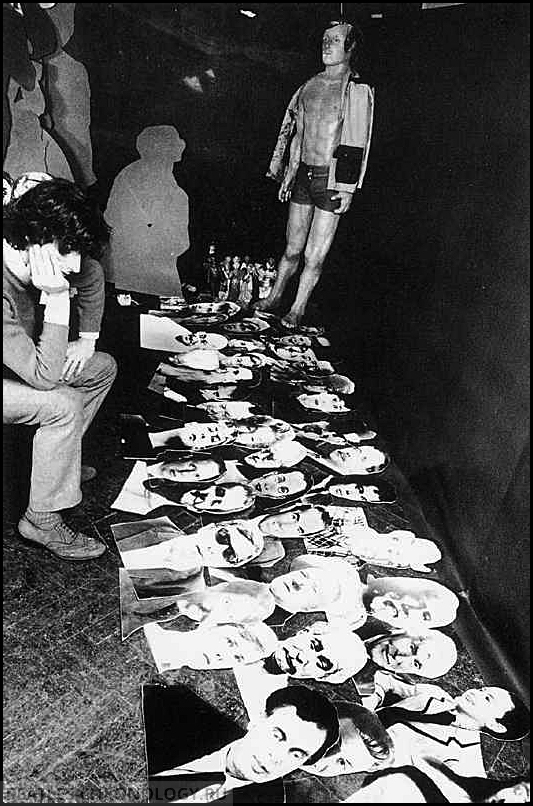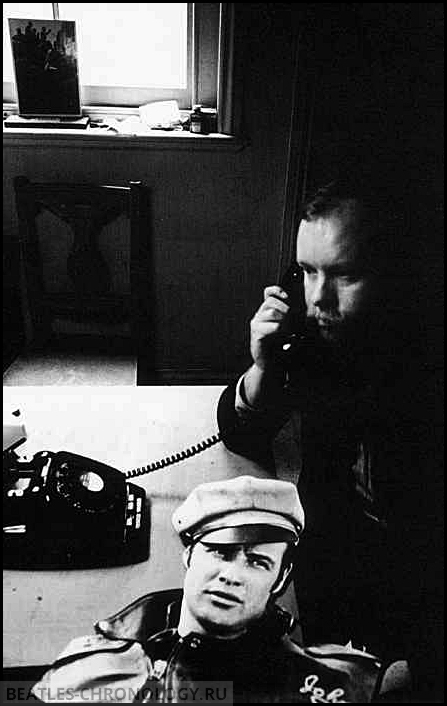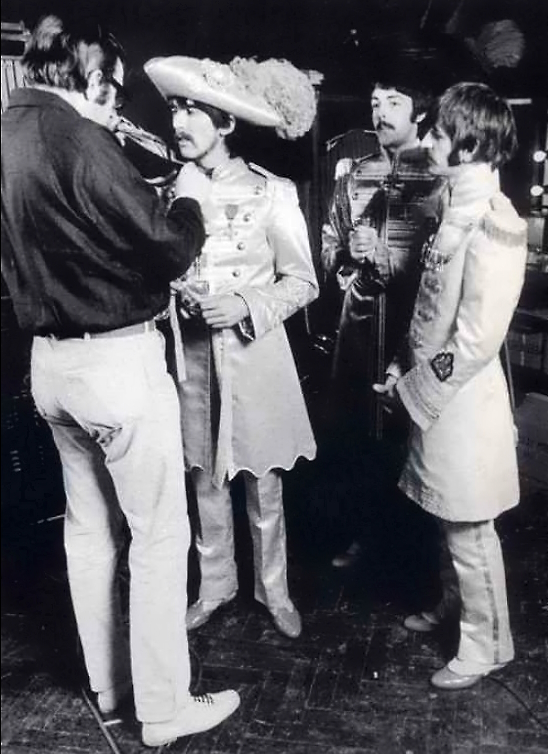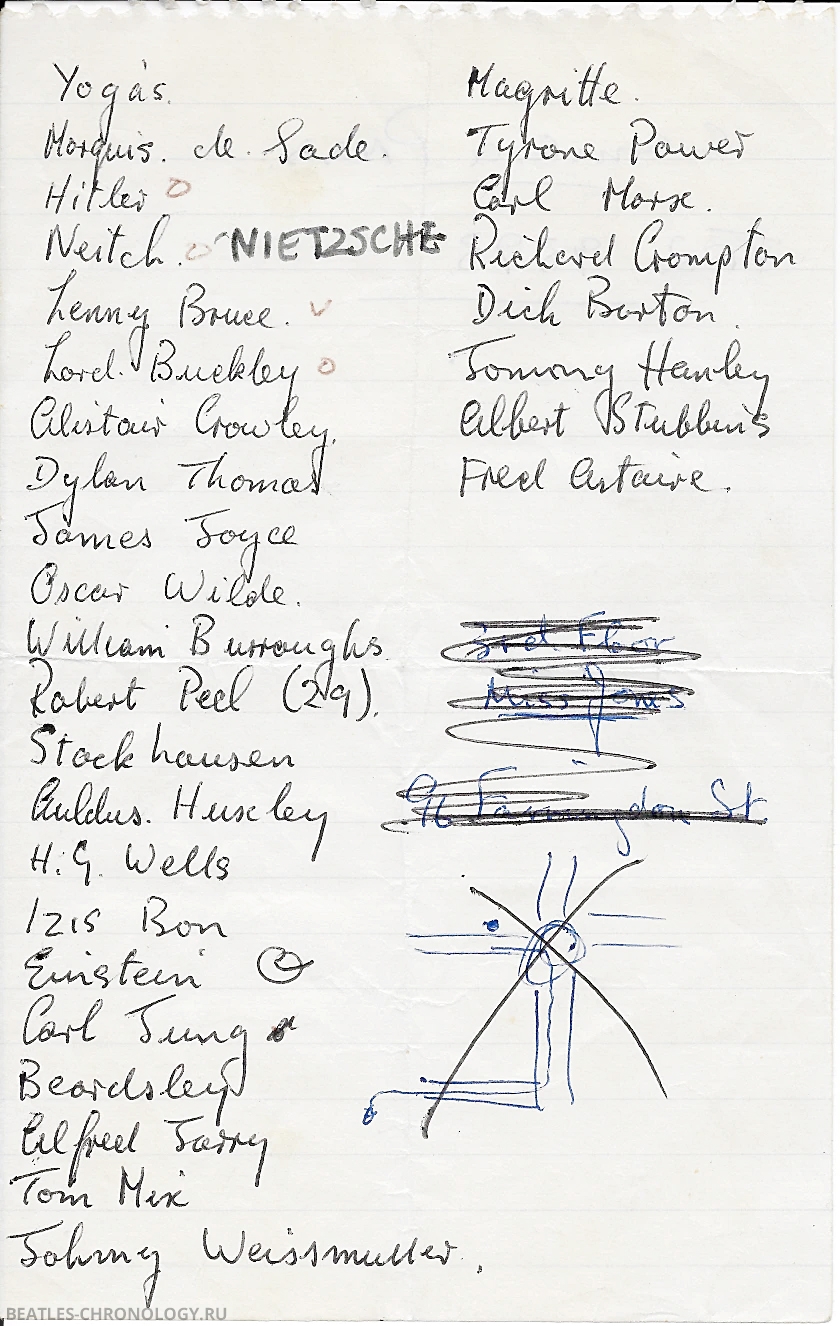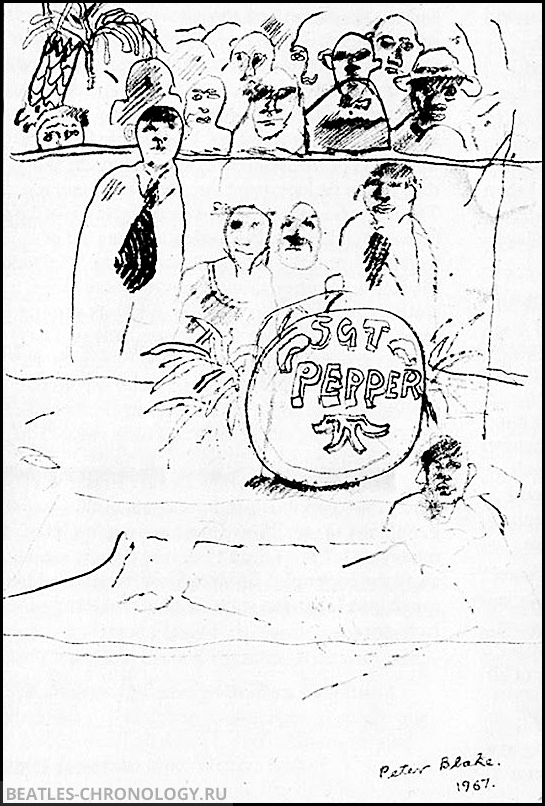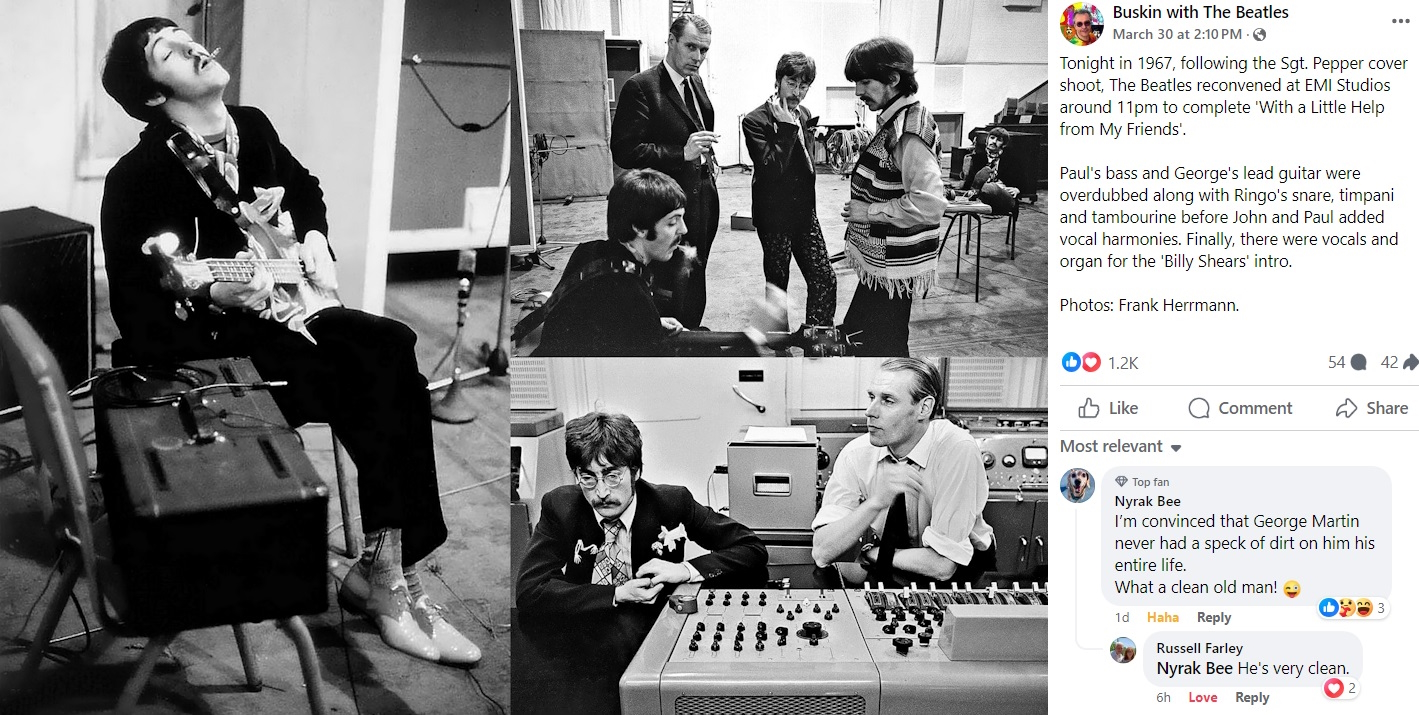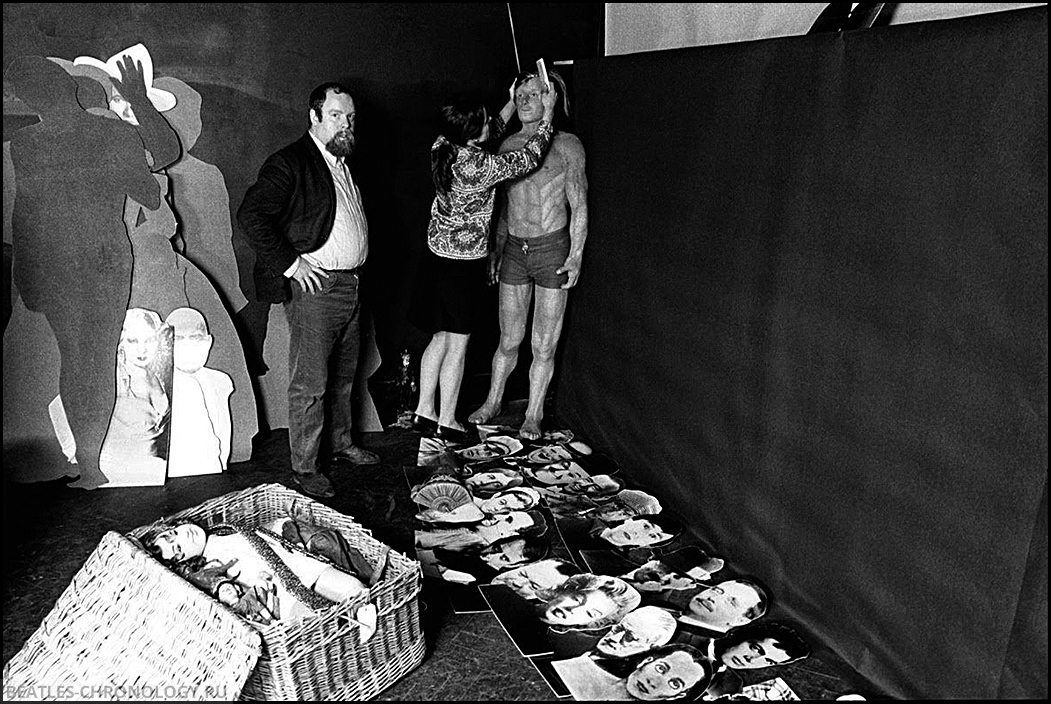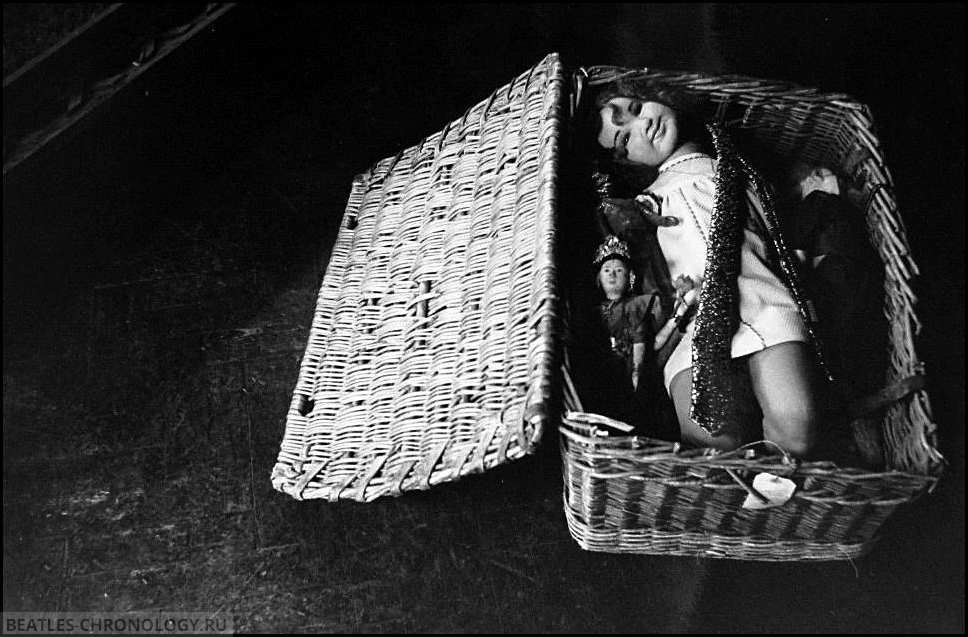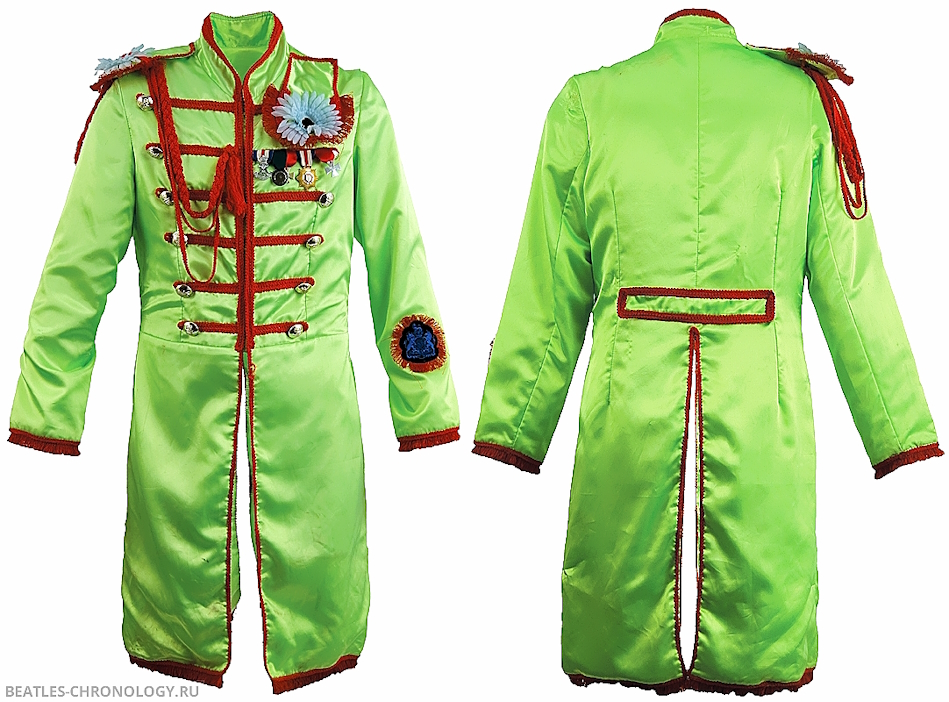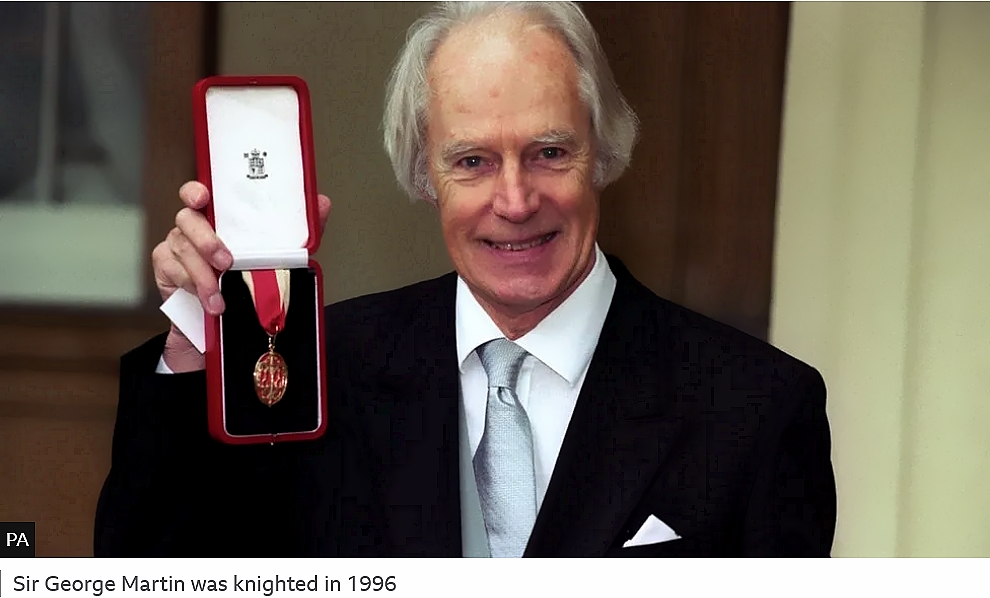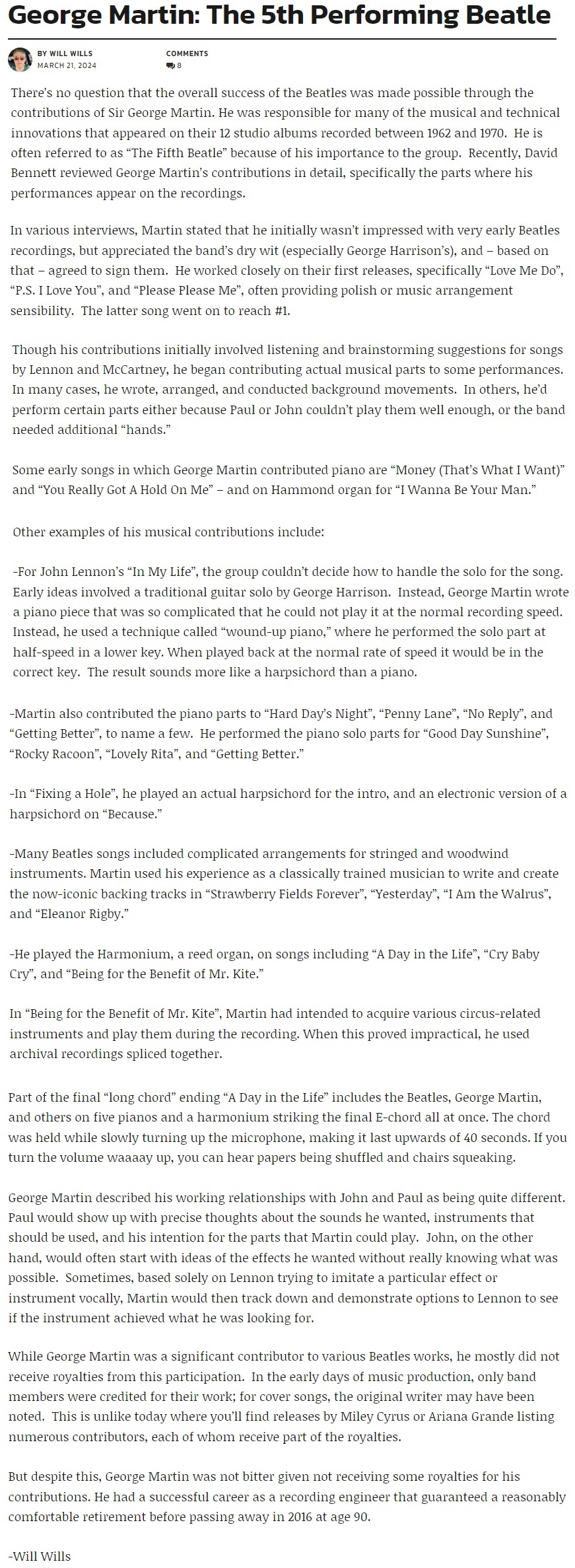|
| |||||||||||||||||||||||||||||||||||||||||||||||||||||||||||||||||||||||||||||||||||||||||||||||||||||||
|
The News Today
April 27, 2024 Ringo Starr talks 'Crooked Boy,' touring and being left-handed | AP full interview With the release of his latest EP "Crooked Boy," Ringo Starr says he's enjoying the freedom that comes with making music later in life. While he typically co-writes his new tunes, this time around songwriter Linda Perry took the reins on all four songs. Starr sat down with AP entertainment journalist Krysta Fauria to talk about bringing levity to his latest songs, touring, drumming with a right-handed kit as a lefty — and how he teaches drumming to newbies.
@dogrose6 wrote: "Great interview! It is a thrill to see Ringo sitting and talking with you across the table. Thanks for hanging in and staying on the air through the years. keeping the great music in the spotlight." New songs from Ringo Starr that were written by Linda Perry Paul McCartney video helps to highlight up-coming release of the "One Hand Clapping" sessions @michaeltriglehmann55 writes: "Jimmy McCulloch kicking the door in and saying hello with incredible guitar playing and solos! The mix here is superb and exciting, making these live in-studio versions sound fresh and new. Paul McCartney knew what he had and what he was doing. A true song writing master of Pop/Rock!"  April 26, 2024 The Beatles’ No. ‘1’ Compilation Is Staging A Comeback By Hugh McIntyre for Forbes
 April 24, 2024 Ringo Starr at Amoeba Records Hollywood April 18, 2024
On this day, Ringo Starr's "Sentimental Journey" LP is released in the United States
The Beatles perform "I Want To Hold Your Hand" and "Girl"  April 23, 2024 Flashback: The Bee Gees Beatles Medley performed August 10, 1973 on The Midnight Special
John Lennon in Sloane Square, Chelsea, London on 10th February 1963
 April 22, 2024 How did The Beatles divide their money? By Jordon Potter for Far Out
The Beatles climbed the rungs to stardom rapidly between 1960 and 1963, a period that saw the initial five-piece with Peter Sutcliffe become a four-piece, with McCartney on bass, Ringo Starr on drums, George Harrison on lead guitar, and Lennon on rhythm. As the band became more professional, touring profusely in the UK and visiting mainland Europe periodically, they relied on the insight of their beloved manager, Brian Epstein.
With Epstein’s eye for commercial strategy, The Beatles blazed a trail to the US. First, the band ravaged the charts, then made history with an appearance on the Ed Sullivan Show in February 1964. The televised concert is one of the most seminal moments in music history and is seen as the first domino to fall in the so-called British invasion wave.
Throughout the 1960s, The Beatles grew from strength to strength, breaching barriers with each new album. Fame hit hard, with screaming hoards forcing the group off the stage in 1966, but they remained prolific as a studio band until 1970. During this final chapter, they led the psychedelic rock wave, revolutionising rock music for further evolution in the 1970s and beyond.
This success brought the Fab Four far above the poverty line, with Lennon splashing out on his famous bespoke Rolls-Royce Phantom V limousine in December 1964. However, as Harrison outlined in his 1966 Revolver contribution, ‘Taxman’, the band suffered huge monetary blows throughout the decade. A year later, the group founded Apple Corps to consolidate their enterprises for efficient (minimal) taxation, but other lurking spectres, such as Allen Klein, posed further threats to runaway riches.
Prior to the establishment of Apple Corps and Epstein’s tragic death in 1967, The Beatles shared their profits down the middle. Following Epstein’s 25 per cent share of the gross gains, the Beatles members evenly split the remaining 75 per cent. However, over time, discrepancies arose, especially between the primary songwriting partnership of Lennon-McCartney and Harrison and Starr.
Lennon and McCartney wrote most of The Beatles’ songs, generating a substantial share of the revenue through record sales and royalties. Consequently, they received a higher share of the songwriting royalties. Harrison and Starr didn’t have as many credits to their names but still received a portion of the profits from album sales, tours, and other ventures. How much money did The Beatles make? As one of the most commercially successful bands and brands of all time, The Beatles turned over a shed-load of money during their run of existence through the 1960s. Determining exactly how much money they made is somewhat complex and involves various factors like record sales, concerts, merchandise, licensing and royalties.
The band’s company, Apple Corps, reportedly turns over approximately $67,000 a day. Between 1962 and 1970, their record sales were worth $17 million, but when the group dissolved in 1970, the members’ net worth was estimated at just under £2m (~$16m today), due to business exploits, shared assets and dubious management. What is Paul McCartney’s net worth now? Although Paul McCartney was never short of lunch money in 1970, his estate entered a blissful state of sustained growth throughout the 1970s and beyond, as he raked in chips from The Beatles, Wings and ongoing solo exploits. Today, the star’s net worth is estimated at a whopping $1.2 billion.
− End of article.
What A Great Letter from John Lennon to George Harrison in 1974 Culled from George Harrison Liverpool Home on Facebook...
 April 21, 2024 The Beatles Record That Made History 60 Years Ago This Month By Andrew for Parlogram Auctions In April 1964 The Beatles held the top 5 places in the American charts in a feat which has never been and will never be broken. The record which topped that chart was their latest single, Can't Bu Me Love' and this video tells the history of that song - from its composition in a Paris hotel room to its retirement from The Beatles' live shows in August 1965. Lost 1970 Beatles Doc ‘Let It Be’ to Stream on Disney+ The documentary, directed by Michael Lindsay-Hogg, will be available to watch for the first time in 50 years. By Alex Weprin for the Hollywood Reporter
Disney+ is adding to its library of music documentaries, bringing a long lost Beatles doc to its slate.
The streaming service is adding the 1970 film Let It Be to its platform, beginning May 8, 2024. It will be the first time that the film, directed by Michael Lindsay-Hogg, has been made available to watch in 50 years.
Peter Jackson’s Park Road Post Production restored the film, with Lindsay-Hogg’s support, allowing for its rerelease. Jackson, of course, directed the 2021 documentary for Disney+ The Beatles: Get Back. Let It Be follows The Beatles as they record the aforementioned album, and as they perform for what would be their final time as a group. Disney says that the background and story provided by Get Back allows for the film to be more fully appreciated, with Jackson and Lindsay-Hogg now voicing support for people to see both projects in a more complete context.
“Let It Be was ready to go in October/November 1969, but it didn’t come out until April 1970. One month before its release, The Beatles officially broke up. And so the people went to see Let It Be with sadness in their hearts, thinking, ‘I’ll never see The Beatles together again. I will never have that joy again,’ and it very much darkened the perception of the film,” Lindsay-Hogg said in a statement.
The director added, “But, in fact, how often do you get to see artists of this stature working together to make what they hear in their heads into songs? And then you get to the roof, and you see their excitement, camaraderie, and sheer joy in playing together again as a group and know, as we do now, that it was the final time, and we view it with the full understanding of who they were and still are and a little poignancy. I was knocked out by what Peter was able to do with Get Back, using all the footage I’d shot 50 years previously.”
“I’m absolutely thrilled that Michael’s movie, Let It Be, has been restored and is finally being re-released after being unavailable for decades,” added Jackson. “I was so lucky to have access to Michael’s outtakes for Get Back, and I’ve always thought that Let It Be is needed to complete the Get Back story… The two projects support and enhance each other: Let It Be is the climax of Get Back, while Get Back provides a vital missing context for Let It Be. Michael Lindsay-Hogg was unfailingly helpful and gracious while I made Get Back, and it’s only right that his original movie has the last word…looking and sounding far better than it did in 1970.” − End of article. Cartoon culled from The Beatles Kingdom Facebook page...
 April 20, 2024 Paul McCartney & Wings One Hand Clapping Live Studio Sessions from 1974 Newly Mixed Now available for the first time Official album from seldom-seen documentary film – featuring several previously unreleased tracks One of music’s most mythical live albums finally to be released
Official Press Release
NEWS PROVIDED BY
16 April 2024 – Available in various formats:
• 2LP/2CD/Digital
The wait is over: With the June 14 release of One Hand Clapping, one of the most bootlegged live albums in musical history will finally receive a proper release. In August 1974, when Band on the Run was enjoying a seven-week consecutive #1 stint at the top of the UK album charts, Paul McCartney and Wings headed to Abbey Road Studios for the filming of a video documentary and possible live studio album – One Hand Clapping. Despite overwhelming demand for newly recorded material from the biggest band in the world at that time, One Hand Clapping was never officially released.
Filmed and recorded over four days and directed by David Litchfield, the release of One Hand Clapping is a historic moment for Paul McCartney fans. Over the years, various parts of One Hand Clapping have been bootlegged with varying degrees of success. Some of the material has also appeared on official McCartney releases. However, the June 14 release of One Hand Clapping, which features the original artwork designed for the project, including a TV sales brochure for the unreleased film at the time, is the first time the audio for the film—plus several additional songs recorded off-camera--have been officially issued.
One Hand Clapping showcased Wings‘ new line-up, fresh off their return from Nashville, where they recorded the classic single Junior’s Farm. Following the sudden departure of Denny Seiwell and Henry McCullough the previous year on the eve of recording the Wings masterpiece Band on the Run, Paul, Linda, and Denny Laine were now joined by guitarist Jimmy McCulloch and drummer Geoff Britton. Additionally joining the band in the studio were orchestral arranger Del Newman and saxophonist Howie Casey, who had previously played with Paul in Hamburg and would go on to join the Wings touring band.
Opening with an instrumental jam that would become the One Hand Clapping theme song, the album features live-in-studio renditions of Wings mega-hits “Live and Let Die,” “Band on the Run,” “Jet,” “My Love,” “Hi, Hi, Hi,” “Junior’s Farm,” Paul’s much loved solo song “Maybe I’m Amazed,” reworked extracts of Beatles’ classics “Let It Be,” “The Long and Winding Road” and “Lady Madonna,” the Moody Blues hit “Go Now” with Denny Laine singing, and a Paul solo piano version of the Harry Akst/Benny Davis Tin Pan Alley classic “Baby Face.”
One Hand Clapping will be released in multiple formats, including an online exclusive 2LP + 7” package featuring an exclusive vinyl single of previously unreleased solo performances recorded on the final day of the sessions in the backyard of Abbey Road studios. These include the unreleased track “Blackpool,” The Beatles’ iconic “Blackbird,” Wings B-side “Country Dreamer,” and cover versions of Eddie Cochran’s “Twenty Flight Rock” (the first song Paul played to John Lennon when they met in 1957) and Buddy Holly’s “Peggy Sue” and “I’m Gonna Love You Too.”
One Hand Clapping serves as a celebration of the enduring legacy of Paul McCartney and Wings. It captured a moment when Wings had found and defined their signature sound – just as Paul had shaped popular culture the decade before with The Beatles, he was doing it once again in the 70s with Wings. This recording gives an insight into the inner workings of the band as they work and play together in the studio. It also underscores Paul’s incredible talent as a live performer: Fifty years on, Paul is still performing many of these songs in packed stadiums across the world. ONE HAND CLAPPING FORMATS2LP + 7” (D2C) *Previously released 2010 Band on
the Run Archive Collection DVD Disc 1 SIDE ONE
SIDE TWO 01.Bluebird* 03:27 Disc 2 SIDE ONE
SIDE TWO
Disc 3 (7”)
SIDE TWO
SIDE ONE
SIDE TWO
SIDE ONE
SIDE TWO
One Hand Clapping will also be
available to stream in Dolby Atmos  April 18, 2024 Presenting the Fab Four :) Rooftop 2024 - Tribute to the Beatles Savile Row '69 Concert By ALVARORTEGA George Harrison performs "For You Blue" live at the LA Forum in 1974
George Harrison 1974 Tour L.A. Forum KMET By KMET 94.7 Radio Former Beatle George Harrison in his first US tour following the breakup of the Beatles, at the L.A. Forum in Inglewood, CA. Recorded and broadcast by Metromedia station KMET 94.7 FM in Los Angeles.
George Harrison and Ravi Shankar's 1974 North American tour was a 45-show concert tour of the United States and Canada, undertaken by English musician George Harrison and Indian sitarist Ravi Shankar in November and December 1974. It is often referred to as the Dark Horse Tour, since the concerts served as a launch for Harrison's record label Dark Horse Records, and Harrison's concurrent single was the song "Dark Horse" The release of his delayed album, also titled Dark Horse, followed towards the end of the tour. The shows featured guest spots by Harrison's band members Billy Preston and Tom Scott.
The 1974 tour was the first in North America by a former member of the Beatles since the band's 1966 visit. Raising expectations further among fans and the media, it marked the first live performances by Harrison since his successful staging of the 1971 Concert for Bangladesh shows, which had also featured Shankar and Preston. Harrison had no wish to revisit his Beatles past, however. In his set list for the tour, Harrison included just four Beatles songs: his own compositions "Something", "While My Guitar Gently Weeps" and "For You Blue", and the Lennon–McCartney song "In My Life".
The response from music critics varied significantly throughout the tour. Some reviewers were scathing in their assessment: Harrison was criticized for failing to respect the public's nostalgia for the Beatles, his choosing to afford considerable stage-time to Shankar's ensemble, his spiritual pronouncements and on-stage demeanor, and particularly the rough quality of his singing voice, caused by overexertion in the months leading up to the opening concert. Other reviews were highly favorable, admiring Harrison's humility in sharing the spotlight with his fellow musicians and the lack of overly theatrical presentation, and praising the breadth and adventurousness of the musical program (from Wikipedia).
Harrison's Band:
George Harrison – Vocals, Electric &
Acoustic Guitars
Billy Preston – Vocals, Organ,
Clavinet, Synthesizer, Backing
Vocals
Tom Scott – Saxophones, Flute
Robben Ford – Electric a& Acoustic
Guitars, Backing Vocals
Jim Horn – Saxophones, Flute
Chuck Findley – Trumpet, Flute
Emil Richards – Marimba, Percussion
Willie Weeks – Bass
Andy Newmark – Drums
Kumar Shankar – Percussion, Backing
Vocals
Ravi Shankar - Sitar & Conductor for
Shankar's orchestra
I was fortunate to go to one of the concerts on this tour, just 2 days before this one, at the Long Beach Arena in Southern California. I have mostly fond memories of this concert, although many music critics and concert-goers had less favorable reviews (see article below).
Cover art derived from a concert poster/flyer for this event.
Read a not-so-favorable review
of George Harrison's 1974 tour:
https://faroutmagazine.co.uk/george-harrison-tour-1974-disaster/
Watch a concert video from this
1974 tour: https://www.youtube.com/watch?v=LGP8FEKnFX8&t=84s
 April 17, 2024 Rolling Stones finally issue an album of original material in the U.K. on April 15, 1966 The following was taken from the official Fab Four FAQ 2.0 on Facebook....
 April 15, 2024 The Meaning Behind The Song: Another Day by Paul McCartney By Lupe Carey for Old Time Music The Emotional Journey of Paul McCartney’s “Another Day” The Background of the Song “Another Day” was one of Paul McCartney’s most successful solo singles ever since he parted ways with the Beatles in 1970. He wrote this poignant song in 1969 and released it in 1971, which captured the hearts of many fans worldwide. The song is about the mundane routine of everyday life, the struggle to find true happiness, and the realization of the fleeting nature of life.
Unpacking the Lyrics
Some of the most striking lines of the song are “Every day she takes a morning bath, she wets her hair, Wraps a towel around her as she’s heading for the bedroom chair… Every day she takes the man who works beside her. He’s a fool, and he thinks he’ll be okay, dragging on, feet of clay,” which illustrate the monotony of life, the routine of waking up, and getting ready for work, returning home at night, and doing it all over again. The outro of the song is incredibly emotional as Paul McCartney sings, “Every day she takes a lonely ride, just another day, no one to run to, nothing to say… Tired of waiting for the night to come, so she could be with someone, weary day, she turns and sleeps alone again.”
The song’s raw vulnerability touches on the deepest emotions of anyone who has ever felt trapped in their everyday life, struggling to find happiness and fulfillment. The Significance of the Song “Another Day” is more than just a song. It is a profound reflection of the human experience, representing the daily struggles that the average person goes through.
The song teaches the listener that in life, many people want something more significant than what they have. It highlights the belief that there is something more meaningful in life than just going to work and returning home every day and that sometimes people feel invisible and unimportant.
For McCartney, the song was his way of expressing the emotions of many of his fans who felt beaten down by the struggles of daily life. The song was a gift to his listeners, telling them that they were not alone, and that he too had gone through similar experiences. Some Final Thoughts “Another Day” is a timeless classic that has captured the hearts of many over the years. The song’s lyrics, melody, and McCartney’s emotional delivery are jewels of artistic expression.
The song is a testament to the human spirit, which reminds us that even in the darkest moments, we can find hope and comfort. It inspires us to believe that we can get through the rough patches of life, and that there is always a light at the end of the tunnel.
Ultimately, “Another Day” is a poignant reminder that life is fleeting and that we must make the most of every day, and every moment, to find meaning and value in our existence.
− End of article.
Jimmy Buffett Tribute: Paul McCartney performs Let It Be at the Hollywood Bowl, 4-11-24
 April 14, 2024 “February Sky” is the first song of four new original tracks on Ringo Starr’s forthcoming ‘Crooked Boy’ EP, all written and produced by Linda Perry. ‘Crooked Boy’ will be available next Saturday, 4/20 on black and white custom marble vinyl exclusively at indie record stores as part of Record Store Day. Listen to Ringo Starr’s New Single, “February Sky,” Written by Linda Perry By Matt Friedlander for American Songwriter Ringo Starr has released a brand-new song, “February Sky,” the lead single from his forthcoming four-track EP, Crooked Boy. The tune is available now via digital formats and streaming. As previously reported, all four songs on Crooked Boy were written by veteran songwriter/producer Linda Perry, who also was the frontwoman of the 1990s alt-rock band 4 Non Blondes.The tune is available now via digital formats and streaming. As previously reported, all four songs on Crooked Boy were written by veteran songwriter/producer Linda Perry, who also was the frontwoman of the 1990s alt-rock band 4 Non Blondes. “February Sky” is a moody-sounding mid-tempo rock song that features lyrics that seem to be about keeping a positive attitude in a time of uncertainty and upheaval. “Gonna stand up rise above the rain / Start a revolution in these dark days,” the former Beatles drummer sings in the chorus. “Find the missing pieces that are vacant to the eye / Had enough of February skies.” “February Sky” features Starr on lead vocals and drums, and guitars by The Strokes’ Nick Valensi and one-time Shania Twain touring band member Josh Gooch. Perry, who produced the track, also contributed bass, guitar, Hammond B3 organ, and backing vocals. About the “February Sky” Visualizer Video To accompany the track, Starr has debuted a companion visualizer video. The black-and-white clip mixes candid archival footage of Starr with scenes of stormy skies, swaying palm trees, seagulls flying overhead, and a churning ocean. Fans React to Starr’s New Song The track got plenty of positive reactions from Starr’s fans, who posted a variety of messages in the comments section of his YouTube channel.
tough guitar sounds are great.
he wrote. “What do you say?”
Crooked Boy Release
Details also will have the chance to purchase an exclusive seven-inch red-vinyl single featuring “February Sky” and anotherCrooked Boytrack, “Gonna Need Someone.”
Visit Amoeba.com for
more details about the event.
six-show
residency at The Venetian. The group also
will be playing a couple of shows in
California and June 5-6 stand in Mexico City
during the trek.
− End of article. The Beatles on Capitol - Second
Album vs Canada's Third - A FULL Investigation
Capitol USA released The Beatles Second in April 1964.
It was followed in a few weeks by Capitol
Canada's third, 'Long Tall Sally' album .
Both appeared similar but had slightly
different track lists and a totally
different sound. In this video we find out
which is best by comparing and contrasting
the artwork, contents and examine the sound
quality of each and find a UK pressing of
this incredible album.
The
Guardian view on George Martin:
instrumental value The great
producer/composer did many splendid
things for the Beatles, but they owe
him a particular debt for
introducing them to the arsenal of
the orchestra
Note: This is a very lengthy essay. Please read on at the Sound and Vision website.  April 10, 2024 Cirque official on closing of ‘The Beatles Love’: ‘It wasn’t our decision’ By John Katsilometes for the Las Vegas Review
The Hard Rock Las Vegas will rock without the Beatles.
“The Beatles Love” by Cirque du Soleil is closing at The Mirage/Hard Rock Las Vegas on July 7. Producers announced the decision Tuesday morning.
Thus ends the only live production anywhere in the world licensed by Apple Corp, the Beatles’ parent company.
Cirque du Soleil CEO Stéphane Lefebvre said Mirage/Hard Rock Las Vegas officials pulled the plug on the show.
“This wasn’t our decision,” Lefebvre said in a virtual interview Tuesday afternoon, after being asked why the show is closing. “As you you know, Hard Rock needs to take control of the entire venue and do some major renovations. So they need to get the show closed by July 7.”
Lefebvre, based in Montreal and Cirque’s top-ranking official said he found out “late last week” the show would be shut down. He also confirmed there are no plans to tour “Love,” a show that would seem to have strong demand internationally.
“If it has a life beyond this venue, it will need to change the format a little bit. The theater is so unique, it’s a 360-degree stage and very deep,” Lefebvre said “If we want to move it elsewhere, if we look at somewhere in Europe, we need to make some significant changes.”
A total of 230 members of the “Love” cast and crew are to lose their jobs as the result of the shutdown.
‘Love’ problems
The future of “Love” had been in question as The Mirage turns over to Hard Rock Las Vegas. The show was reportedly running between 40- and 60-percent capacity in its 2,013-seat theater. That is the lowest box-office performance of Cirque’s six productions on the Strip.
The loss of “Love” creates a void among Cirque shows in Las Vegas. The company still operates “Mystere” at Treasure Island, “O” at Bellagio, ‘Ka” at MGM Grand, “Michael Jackson One” at Mandalay Bay and “Mad Apple” at New York-New York.
Cirque also owns Blue Man Group at Luxor and is a partner in the outgoing “America’s Got Talent Live — Superstars” show at Luxor.
Lefebvre addressed possible new Cirque projects, saying, MGM Resorts International remains the company’s primary Las Vegas partner, though Cirque is in partnership with Phil Ruffin with its longest-running show, “Mystere” at Treasure Island and is closing out its business relationship with Hard Rock.
“MGM is by far is our strongest and most important partner,” Lefebvre said. “I think first and foremost, before we start looking around at other potential partners, we really want to do something with MGM. Absolutely.”
The MGM portfolio now includes Cosmopolitan, where Spiegelworld’s “OPM” closed earlier this year. Lefebvre said investigating that space, among other smaller-scale opportunities “could be interesting for us, clearly.”
The future of “Love” had been in question as The Mirage turns over to Hard Rock Las Vegas. The show was reportedly running between 40- and 60-percent capacity, the lowest box-office performance of Cirque’s six productions on the Strip.
‘A captivating show’
Mirage President Joe Lupo praised the show, which will have run for about a year and a half under his company’s stewardship of the resort.
“Throughout its historic 18-year run at The Mirage Las Vegas, ‘The Beatles Love’ has been a captivating show that has delighted millions of guests as they shared in the wonder of Cirque du Soleil,” Lupo said in a statement. “I want to share my sincere appreciation to MGM and the entertainment team who ensured that the show’s legacy continued during our ownership transition.”
Lupo also thanked the Cirque performers and team members, adding, “The closure marks the continued construction that directly impacts daily offerings, as we continue the process of transforming our property into the Strip’s newest icon.”
When “Love” bows out, Cirque will have closed three shows in a little more than four years. “R.U.N” at Luxor came and went in five months ending in March 2020. “Zumanity” at New York-New York did not return after the pandemic shutdown, closing permanently in November 2020. “Mad Apple” replaced “Zumanity” in the same theater in May 2022.
‘Love’ history
The decision ends a wondrous production that opened in June 2006, with Paul McCartney, Ringo Starr, Yoko Ono and Olivia Harrison — the widow of George Harrison — in attendance. McCartney and Harrison scouted “O” at Bellagio together in 2001 to gauge how The Beatles’ music and images could blend with Cirque artistry.
Harrison was a close friend of Cirque co-founder Guy Laliberte, with the idea from the show hatched between the two at the F1 Montreal Grand Prix in 2000. With Harrison leading the initial vision for the show, Laliberte steered the production to creation at the Mirage.
The Love Theatre took over the former Siegfried & Roy Theater at the resort.
According to Cirque figures, a total of 44 nationalities are represented. The show required 11,600 costume pieces, 250 pairs of shoes, and 225 wigs each night. A total of 750,000 lumens in projections, 500 props and scenic pieces were required to put on the show.
Upcoming moves
The closing of “Love” is not the only shift in the entertainment landscape at The Mirage. Current Mirage Theater headliner Shin Lim is also the focus of speculation he will be leaving the resort this summer. Several interested parties are reportedly attempting to lure the headlining magician.
The Mirage Theater’s former Aces of Comedy program, developed under MGM Resorts, ended with the hotel’s sale to Hard Rock. Several familiar headliners (including David Spade, Ron White and Ray Romano) moving to other venues on the Strip.
The Center Stage series is holding down the comedy programming in the short term, alternating showtimes with Lim. His post-Mirage plans should be announced soon.
Meantime, “Love” will fade out after playing to more than 11.5 million ticket-holders in its 18-year run. Every performance closes with “All You Need Is Love.” That is how we will remember this show.
− End of article.
Linda Perry produces Ringo Starr's upcoming EP release "Crooked Boy" By Beatlefan from Facebook...
 April 9, 2024 How Do You Make a Dr. Who Episode About the Beatles Without the Music? By Ryan Britt for Inverse The biggest band in history, perhaps not surprisingly, has a long history with science fiction and fantasy. But how do you a sci-fi story about the Beatles? The most obvious answer is probably the 2019 alternate universe film Yesterday (imagine there’s no Beatles!) while the more obscure example would be the classic Quantum Leap episode, “The Leap Home,” in which Sam sings “Imagine” to his sister, two years before the song was even released. But both examples come to the same conclusion: If you’re gonna do sci-fi about the Beatles, you’ve got to have Beatles songs, right?
According to Doctor Who showrunner Russell T. Davies, maybe you don’t need Beatles music to do Beatles sci-fi. In a new interview with Empire, doing a Beatles sci-fi story without Beatles music paradoxically became a solution, rather than a problem. DOCTOR WHO AND THE BEATLES In the upcoming relaunched Doctor Who Season 1 (2024), the Doctor (Ncuti Gatwa) and Ruby Sunday (Millie Gibson) will travel to the 1960s in the forthcoming episode “The Devil's Chord,” and, at some point, cross paths with the Beatles. Interestingly, this is the second time the Beatles have appeared on Doctor Who. During the 1965 1st Doctor (William Hartnell) serial “The Chase,” the Doctor, Vicki, Ian, and Barbara all watched the Beatles on a device called a Time-Space Visualizer. That footage featured the Beatles playing “Ticket to Ride” on the live music show Top of the Pops. Interestingly, this footage was not preserved by Top of the Pops, meaning it only exists in Doctor Who. But, to make matters even stranger, today, you can’t actually see the Beatles in the 1965 Doctor Who episode “The Chase,” because copyright laws prevent that footage of the Beatles and the song, “Ticket to Ride,” from being heard in Doctor Who. This retroactive change means that when you watch “The Chase” on Britbox, you won’t see the Beatles.
THE BEATLES COPYRIGHT CHALLENGE have faced similar problems. The 1994 biopic Backbeat — which chronicles the Beatles' early days in Hamburg — features no actual Beatles music. Meanwhile, the 1979 movie Birth of the Beatles (helmed by Return of the Jedi director Richard Marquand!) used cover versions of most Beatles songs to avoid copyright
issues
of the time.
screen
because the copyright is too expensive...
That’s where the idea came from — copyright
law! We don’t know the exact plot of “The Devil's Chord,” but there’s a good bet that the Doctor will almost certainly inspire a classic Beatles song. We’ll just have
to read between the lines to figure out
which one. compact cassette in the late 1960's EMI totally reconfigured The Beatles albums to fit the new formats making them unrecognizable from their vinyl
counterparts. I this video we
look not just the history of the format but
what each album looked like in the alternate
reality of tape.  April 7, 2024 Sgt. Pepper's parody of the "Yesterday and Today" album cover
Flashback: Scottish singer Lulu rocks it up by doing a Ringo Starr cover of "It Don't Come Easy" Flashback: Olivia Newton-John rocks it up by doing a George Harrison cover of "What Is Life"  April 6, 2024 Beyoncé Made My Favorite Beatles Song Even Better By Garrie Chaverst for the Everygirl.com
I was pulling into my driveway the first time I heard Beyoncé’s BLACKBIIRD on Cowboy Carter. My jaw immediately dropped, and I ran straight inside to continue listening to this new version of one of my
favorite Beatles songs. By the end
of that two minutes and 11 seconds, I had
chills all over my body. I have been a Beatles fan for as long as I can remember. Some of my earliest memories are of Saturday mornings with my mom, listening to Beatles records on repeat. I grew up with The Beatles as a constant feature in the soundtrack of my life. My mom strummed her guitar while singing Norwegian Wood in our little one-bedroom apartment. Blasting Oh! Darling as I drove around the city at 16. Seeing Paul McCartney live. Honest to God, suggesting to my husband that we name our future kids Jude and Eleanor (IYKYK). Getting the lyrics “I’ll follow the sun” tattooed on my arm. And walking down the aisle to a beautiful instrumental rendition of In My Life. The Beatles are in my bones—as central to who I am as a person as my name.
While I love The Beatles fiercely, I also love when artists put their own spins on Beatles music. In fact, there are certain covers I firmly believe outshine the originals (Fiona Apple’s rendition of Across the Universe is one of the most beautiful songs I’ve ever heard). So, to say I was thrilled when the familiar strums of Blackbird started unexpectedly playing after the opening track of Cowboy Carter would be an understatement. After my first full playthrough of the album, BLACKBIIRD was the first song I relistened to. I immediately added it to my liked songs on Spotify, as well as my ultimate plane playlist. As I got online to see what everyone else thought of Beyoncé’s latest, I found that I wasn’t alone. The album is a massive hit (it is excellent), and BLACKBIIRD is just one of a handful of songs that left an impression on listeners.
Originally featured on The Beatles’ self-titled album in 1968, Paul McCartney has said that he and John Lennon were inspired by the Civil Rights Movement happening in the United States when they wrote Blackbird. Specifically, McCartney was inspired by the Little Rock Nine, the nine Black students who, following the Brown v. Board of Education Supreme Court ruling to desegregate schools, became some of the first Black children to enroll at a white high school in Little Rock, Arkansas.
Those nine children faced such extreme discrimination and harassment that President Eisenhower sent federal troops to escort them to their first day of classes. McCartney, watching all of this unfold from the U.K., wrote Blackbird to give Black people—and Black women in particular—a little bit of hope. By writing, “Take these broken wings,” he acknowledged the profound struggle and sense of defeat that comes from fighting what at some points felt like a losing battle. By following that line with “and learn to fly,” McCartney encourages those fighting to keep fighting and reminding them that this is their moment. The song is beautiful in its simplicity—a stripped-back guitar-focused performance with a melody that evokes peace and a message of hope. The song’s impact, however, is anything but simple. In the ’60s, it was a signal from across the pond that Black people had support in their fight.
I loved The Beatles growing up—and I loved Blackbird especially, but I had no clue that the song was inspired by Black women. I simply thought it was a sweet little tune. Now that I’ve grown to embrace my identity as a Black woman, Beyoncé’s BLACKBIIRD makes one of my favorite Beatles songs that much better. Growing up, being Black was not a central part of my identity. Most of the people in my life were (and still are) white. Outside of my family, there were never too many people around who looked like me. Between the girls I played soccer with and against and my friends and peers at school, being Black didn’t mesh with what I thought I needed to be to “fit in.” Consequently, this part of my identity is one I’ve only gotten to know and love as an adult. It started with embracing my natural hair in college and has expanded into educating myself on the deep history of Black culture in this country.
By covering Blackbird on Cowboy Carter, Beyoncé does two crucial things: She shines a light on the forgotten history of a quintessential Beatles song and gives it new meaning by featuring four Black female country singers: Tanner Adell, Tiera Kennedy, Brittney Spencer, and Reyna Roberts. The fight for equality is ongoing; it just looks different than it did in Little Rock after Brown v. Board. Today, Black country artists like Adell, Kennedy, Spencer, and Roberts are fighting tooth and nail to be accepted by the white-dominated country genre. Beyoncé featuring these artists on BLACKBIIRD is an extremely intentional choice. It harkens back to the fight that originally inspired the song while simultaneously lifting up the Black artists fighting for a seat at the country music table now. Cowboy Carter was always going to be a mainstream hit, and now the four artists she sings those powerful, hopeful lyrics with have a platform to further their fight for acceptance in a world where most would prefer to pretend they don’t exist.
This is why Beyoncé’s BLACKBIIRD is an enhancement of the original Beatles tune. In the ’60s, the message was one of support from afar—welcome, to be sure—but by singing it themselves, Beyoncé and her collaborators are sending a message to the country music industry: Black country artists are here now, have been here, and are here to stay.
For me, this new version of Blackbird is a personal reminder of how far I’ve come in embracing my identity. Yes, The Beatles still (and always will) hold a special place in my heart, but Beyoncé’s BLACKBIIRD is a message tailor-made to me and all other Black women: keep going. In whatever it is, remember your strength. Take up space. You’ve got this.  April 5, 2024 Confirmed: Beyoncé's 'Blackbird' Used Original Backing Track From the Beatles Song THE 56-YEAR-OLD SONG STILL REVERBERATES FOR ALL THE RIGHT REASONS. by Amy Hughes for Q
Beyoncé, Paul McCartney and various sources have confirmed in a story via Variety that the Beatles' 1968 song "Blackbird" is indeed the rendition heard on the Cowboy Carter track "Blackbird."
McCartney's acoustic guitar and foot-tapping (specifically miked by engineer Geoff Emerick at McCartney's request) are the basis and source backing for "Blackbiird." While credits have been coming out slowly for all 27 songs, for this track, Beyoncé, McCartney and John Lennon are listed as songwriters and McCartney is included as a producer (along with Beyoncé and Khirye Tyler).
The 56-year-old song still reverberates for all the right reasons. Initially conceived by McCartney after the Beatles return from their meditation retreat in Rishikesh, India, he wrote the song in April 1968 at his High Park Farm in Kintyre, Scotland. Basing the melody off J.S. Bach's "Bourree in E minor," he brought the song to George Harrison's house where, in addition to Lennon who supplied chirping noises, they committed a demo to tape in late May.
McCartney brought "Blackbird" into EMI Studio Two on June 11 as the first song he wanted to record for what would become known as the "White Album." Harrison and Ringo Starr were not present during the session and Lennon stayed only briefly before leaving to gather sound effects for his composition "Revolution 9."
Producer George Martin was in the control room with Emerick as McCartney was being filmed for a short promo be shown to executives at EMI and Capitol Records. McCartney did 32 takes of "Blackbird" with just himself on his 1967 Martin D-28 acoustic guitar and vocal along with his tapping feet and, as notated from The Beatles Recording Sessions, bird sound effects were "courtesy of Volume Seven: Birds Of Feather from the Abbey Road taped sound-effects collection."
"Blackbird" appeared as track three on Side Two of The Beatles (aka the White Album), released in the U.S. on November 25th, 1968. He was never able to play the song while the Beatles were still a unit, however, he eventually started to incorporate it during the Wings Over America tour in 1976 and continues to perform it in concert.
To swing the pendulum back to the present day, one can see why this song has personal meaning for Beyoncé, who recruited four Black women country singers – Tanner Adell, Tiera Kennedy, Reyna Roberts and Brittney Spencer – to provide harmony vocals for her rendition.
During his One on One world tour in 2016, McCartney who had at various times throughout his career made mention of the lyrical inspiration for the song, on this night at the tour's stop in Little Rock, Arkansas, met two women who were part of the Little Rock Nine: African American students who became the first to attend Little Rock Central High School in 1957, desegregating the school and becoming symbols of the American civil rights movement.
"Way back in the '60s, there was a lot of trouble going on over civil rights, particularly in Little Rock," he said from the stage that night. "We would notice this on the news back in England, so it's a really important place for us, because to me, this is where civil rights started. We would see what was going on and sympathize with the people going through those troubles, and it made me want to write a song that, if it ever got back to the people going through those troubles, it might just help them a little bit."  April 4, 2024 Beyonce biggest fan has now become Sir Paul McCartney
Peter Brown, One of the Beatles’ Closest Confidants, Tells All (Again) At 87, the dapper insider is releasing a new book of interviews conducted in 1980 and 1981 with the band and people nearest to it. By Ben Sisario for the New York Times Peter Brown stood in his spacious Central Park West apartment, pointing first at the dining table and then through the window to the park outside, with Strawberry Fields just to the right.
“John sat at that table looking through here,” Brown said, “and he couldn’t take his eyes off the park.”
That’s John as in Lennon. And the story of the former Beatle coveting this living-room view in 1971 — and how Lennon and his wife, Yoko Ono, eventually got their own place one block down, at the Dakota — is just one of Brown’s countless nuggets of Fab Four lore. In the 1960s he was an assistant to Brian Epstein, the Beatles’ manager, and then an officer at Apple Corps, the band’s company. A key figure in the Beatles’ secretive inner circle, Brown kept a red telephone on his desk whose number was known only to the four members. And it was Brown who, in 1969, informed Lennon that he and Ono could quickly and quietly wed in a small British territory on the edge of the Mediterranean, a piece of advice immortalized in “The Ballad of John and Yoko”: “Peter Brown called to say, ‘You can make it OK/You can get married in Gibraltar, near Spain.’” Next week, Brown and the writer Steven Gaines are releasing a book, “All You Need Is Love: The Beatles in Their Own Words,” made up of interviews they conducted in 1980 and 1981 with the band and people close to it, including business representatives, lawyers, wives and ex-wives — the raw material that Brown and Gaines used for their earlier narrative biography of the band, “The Love You Make: An Insider’s Story of the Beatles,” published in 1983.
Now 87, Brown is a polarizing figure in Beatles history. He was a witness to some of the band’s most important moments and was a trusted keeper of its secrets. “The only people left are Paul and Ringo and me,” he said.
On a tour of Brown’s apartment, the spoils of his access were everywhere. In his bedroom, Brown showed off an original image of the cover of “Sgt. Pepper’s Lonely Hearts Club Band,” with background figures (like Gandhi) that didn’t make the final cut. In the dining room are binders and boxes stuffed with Beatle-related snapshots and correspondence.
But the publication of “The Love You Make” four decades ago also made him a kind of villain. According to Brown, the band agreed to interviews to set the record straight about its history. Yet the book — primarily written by Gaines, a journalist and biographer known for detailed, warts-and-all portraits — was seen as tawdry and sensational, preoccupied with sex lives and internecine conflicts, with music a secondary subject. Excerpts ran in National Enquirer.
To the band and many of those around them, it was seen as a betrayal. Paul McCartney accused Brown of misleading him by pitching it as a more general book about music in the 1960s. Linda McCartney said she and Paul burned it.
“That book was a shame,” Mark Lewisohn, the pre-eminent Beatles scholar, said in a recent interview.
“It’s almost like there are two different Peter Browns,” Lewisohn added. “There’s the Peter Brown I know, who is this upright, respectable, very successful businessman. And then the one who attached his name to this Steven Gaines book.”
Brown has heard all the criticism before, and waves it off. Sitting in a chair he inherited from Epstein — and dapper as always in a purple button-down shirt and charcoal slacks — Brown said the book stands as an accurate portrayal, and that the Beatles knew full well what they were getting into.
“There was never any effort on my part to make it negative,” Brown said in his unflappably gentle voice, as classical music wafted quietly through his home. “And nobody’s ever questioned that it was true.”
He also rejected McCartney’s version of events. “Paul imagines things,” Brown said. “Everything he does, he has his own way of remembering, and he’s crazy about it.”
Gaines, for his part, attributes the notoriety of the original book to his and Brown’s refusal to produce a sanitized hagiography, and their decision instead to publish controversial private details. Among those was a rumor that Lennon once had a sexual encounter with Epstein, which Brown and Gaines reported as fact, based on their research.
“Nobody had put something like that in a book,” Gaines said. That episode, on a trip to Spain in 1963, has been debated for years by Beatles commentators. Lennon denied having sex with Epstein, saying in an interview with Playboy: “It was almost a love affair, but not quite. It was never consummated.”
Brown and Gaines’s new book, “All You Need Is Love,” goes even deeper into Beatle lore than their first. It offers an extended transcript of Ono denying, not too persuasively, that she introduced Lennon to heroin, and includes various firsthand accounts of the threats and chaos the band faced on tour in Manila in 1966. Ron Kass, who led the Beatles’ Apple label, describes the impossibility of running a business with Lennon and McCartney as the bosses. One, he says, wanted the label design to be green, the other white; Kass decided to make each side a different color.
There are also startling comments from McCartney and George Harrison about Lennon, revealing the tension and raw feelings that were still present a decade after the band broke up, in interviews recorded just weeks before Lennon was killed in December 1980. Harrison calls his former bandmate “a piece of [expletive]” and wonders why he had “become so nasty.”
McCartney describes Lennon and Ono as “very suspicious people,” and portrays his relationship with them as a kind of power struggle.
“The way to get their friendship is to do everything the way they require it. To do anything else is how to not get their friendship,” McCartney says in the book. “I know that if I absolutely lie down on the ground and just do everything like they say and laugh at all their jokes and don’t expect my jokes to ever get laughed at,” he adds, “if I’m willing to do all that, then we can be friends.”
Lennon never got a chance to respond, Brown said. “I spoke to John, and said, ‘Listen, I’m coming to New York to do some of the recordings,’” he recalled. “And he said, ‘Yes, fine. Looking forward to it.’ And that was the week before he was murdered.” Ono’s interview was done a few months later, in the spring of 1981.
As with many Beatles histories, there are plenty of contradictions, opposing perspectives and selective memories. Interviews with the manager Allen Klein and the lawyer John L. Eastman offer an icy tit-for-tat on the battle for business control during the band’s last days. And Alexis Mardas, a.k.a. Magic Alex, the supposed inventor who others in the book call a con man, gives his account — with skeptical footnotes added by Brown and Gaines — of the Beatles’ retreat in India in 1968.
When asked about finding the truth amid contrasting accounts in an oral history, Brown turned philosophical. “It depends on where you’re sitting,” he said.
There are even conflicting stories about the genesis of Brown and Gaines’s new book. According to Brown, it began when a New York Times reporter — me — asked him for comment three years ago about “The Beatles: Get Back,” Peter Jackson’s exhaustive look at the band’s stormy recording sessions in early 1969. Brown realized then, he said, that he was one of the last remaining witnesses to important history.
But Gaines said that the origins of the project go back years before, to when he wondered what to do with the original interview tapes, which were languishing in his safe deposit box on Long Island. Gaines said he considered donating or selling them, but Brown demurred. They settled on a book of edited transcriptions, though they still squabble over details like ownership of the tapes. “It’s ‘Rashomon’ with Peter,” Gaines said.
After Brown quit his work with the Beatles on Dec. 31, 1970 — the day that McCartney filed a lawsuit to dissolve the band’s partnership — he came to the United States and worked with Robert Stigwood, the Australian-born entertainment mogul who had huge hits in the 1970s with the Bee Gees and the films “Saturday Night Fever” and “Grease.” Then Brown founded a public relations firm, BLJ Worldwide, which in 2011 came under scrutiny for its work representing the families of Muammar el-Qaddafi in Libya and of Bashar al-Assad in Syria. Brown declined to speak about that episode on the record.
But he remains most proud of his association with the Beatles, and said he viewed “All You Need Is Love” as a final gesture defining his legacy with the band.
“This is the end of it,” he said. “Hopefully we’re closing the door now.”  April 3, 2024 John and Paul almost appeared on Saturday Night Live
The following excerpt is from a write-up by Jordan Runtagh for People magazine...
On April 24, 1976, they [John and Paul] settled in to watch the hip new comedy program, Saturday Night Live, when they found themselves in the peculiar situation of being addressed on air by the show’s producer, Lorne Michaels. Mocking the exorbitant sums of money the Beatles were being offered to reunite, Michaels held up a hilariously paltry check for just $3,000. Amazingly, the joke nearly succeeded. “John said, ‘It's only downtown, we could go now. Come on, let's just show up. Should we, should we?’ and for a second it was like, ‘Yeah, yeah!’ But we decided not to.” (Lennon admitted, “We nearly got a cab, but we were actually too tired.”)
The night was reportedly be the last time the two men, who had shared so much over the previous two decades, ever shared a room. As they parted ways, Lennon patted McCartney on the shoulder and offered a mock-maudlin farewell: “Think about me every now and then, old friend.” Circe Link does a Beatles cover version of "Baby You're A Rich Man" By Andrew from Parlogram Auctions For me, there is no such thing as the Beatles worst song. Instead there are some you just like more than others. In this video, we took the data from over 100 Beatles fans who were asked what their least liked Beatles song was and put those results into this top 10. I'm sure there will be disagreements about the content of such a list, but it's all good fun and there are some interesting stories behind some of these tracks.  April 2, 2024
Beytlemania
'Cowboy Carter' highlight brings
the White Album classic full circle
Beyoncé has so many audacious culture-clash triumphs all over Cowboy Carter. But one of the most stunning moments is also one of the simplest: her version of the Beatles classic “Blackbird.” Paul McCartney wrote the song in the summer of 1968, inspired by the American civil rights movement. All that history is right there in Beyoncé’s version. She keeps the folkie Paul guitar, complete with the squeaks, but adds her heavenly gospel-soul harmonies. What she does with the word “arise” is incredible in itself.
It’s a stroke of Beyoncé’s revisionary genius that brings the story of “Blackbird” full circle. She claims the song as if Paul McCartney wrote it for her. Because, in so many ways, he did.
Paul tells the story of writing it in his 2021 book The Lyrics. “At the time in 1968 when I was writing ‘Blackbird,’” he recalls, “I was very conscious of the terrible racial tensions in the U.S. The year before, 1967, had been a particularly bad year, but 1968 was even worse. The song was written only a few weeks after the assassination of Martin Luther King Jr. That imagery of the broken wings and the sunken eyes and the general longing for freedom is very much of its moment.”
Paul wrote this song as a dialogue with Black America; Bey’s “Blackbird” is part of that call-and-response, proof that the song always meant exactly what McCartney hoped it would mean. It’s one of the most profound and powerful Beatles covers ever, right up there with Aretha Franklin’s “The Long and Winding Road.”
“I had in mind a Black woman, rather than a bird,” Paul says of the song in the 1997 book Many Years From Now, by Barry Miles. “Those were the days of the civil rights movement, which all of us cared passionately about, so this was really a song from me to a Black woman, experiencing these problems in the States: ‘Let me encourage you to keep trying, to keep your faith, there is hope.’”
Paul was especially moved by the Little Rock Nine — a group of teenagers, the same age as so many Beatlemaniac fans, who caused a nationwide racist outrage in 1957 when they tried to enroll in an all-white high school in Little Rock, Arkansas. Gov. Orval Faubus called out the National Guard to block the kids from setting foot in the school. Writing “Blackbird” in the summer of 1968, with high-profile anti-Black violence in both the U.S. and the U.K., he turned that into the song. “As is often the case with my things, a veiling took place so rather than say ‘Black woman living in Little Rock’ and be very specific, she became a bird, became symbolic, so you could apply it to your particular problem.”
“Blackbird” is a song with a long history in Black music, from reggae (the Paragons’ gorgeous version from 1973) to jazz legends including Ramsey Lewis, Sarah Vaughn, and Cassandra Wilson. No song has a deeper dialogue between the Beatles and the Black America that gave them their voices. Anderson .Paak put his spin on “Blackbird” in 2013, years before he ended up contributing to Paul’s album McCartney 3 Imagined, with his funk remix of “When Winter Comes.” The Beatles’ sidekick Billy Preston, who plays with them all over the Get Back movie, gospelized it in 1972, as the flip side of his Number One hit “Will It Go Round in Circles.” His version is on the superb Ace Records anthology Come Together: Black America Sings the Beatles.
Beyoncé brings all that history to her version. There’s also a Paul-like playful humor in the way she makes a horse the star of her album cover. (Could Chardonneigh be the new Martha?) In other words, she is Macca Fierce.
But most of all, Bey’s version ties in most directly to Sylvester’s disco version of “Blackbird” from 1979, the most outrageous and radical version ever. She evokes this song’s history in queer Black disco culture— connecting it to her whole Renaissance project. Sylvester was the first gay Black pop star who was out of the closet, as far as the public knew. Tragically, he also become one of the first stars to pass in the Eighties AIDs epidemic. But in 1979 he was back in San Francisco as a hometown hero, after breaking big nationwide. “Blackbird” is his falsetto-disco celebration from Living Proof, one of the Seventies’ greatest live albums. He was on top of the world: There was an official “Sylvester Day” in San Francisco, where he received the key to the city from the mayor, who happened to be Diane Feinstein. That night he headlined the War Memorial Opera House, and did the most beautiful “Blackbird” ever heard — until now.
Sylvester claims “Blackbird” for himself and his community. He trades call-and-response vocals (“Y’all ready, girls?”) with his backup singers, eternal disco legends Martha Wash and Izora Rhodes, the Two Tons o’ Fun. (They later blew up as the Weather Girls, belting their classic “It’s Raining Men.”) When they sing “You were only waiting for this moment to arise,” you can feel the whole crowd rise to join them. They’re not hiding out in the shadows anymore. They’re spreading their wings. It’s their night to fly. This is their song, and their moment.
Hearing Beyoncé sing this song now evokes her Uncle Johnny, a member of the queer Black dance culture that Sylvester epitomized, and the guiding spirit of her love letter to that culture, Renaissance. (He died tragically in the same epidemic as Sylvester, 10 years later.) You can hear her “arise” connect with Sylvester’s “arise.” And you can hear her Uncle Johnny in both of them.
Beyoncé has always loved reclaiming rock & roll as Black female performance. It’s one of her artistic passions — check her mind-blowing versions of the Doors’ “Five to One,” Alanis Morissette’s “You Oughta Know,” and even Kings of Leon’s “Sex on Fire.” She turned the Yeah Yeah Yeahs into “Hold Up.” Long before Stevie Nicks had her grand 2010s comeback, Destiny’s Child got her back on MTV with “Bootylicious.” Most spectacularly, the Lemonade classic “Don’t Hurt Yourself” is Beyoncé channeling Memphis Minnie’s “When the Levee Breaks” through Led Zeppelin, with Jack White wailing on guitar. But “Blackbird” is different, because McCartney wrote the song explicitly about Southern Black women and their struggle through American racism in the 1960s.
The Bey/Paul connections go deep. Bey and Paul were spotted hanging out at Coachella a decade ago; they also worked out together at an L.A. gym. He was visibly having a great time at her 2011 New York residency. He saw the Renaissance World Tour in London last summer — a clip of his dancing went viral — and posed for a memorable photo with Jay-Z, lifting their champagne glasses to toast the Queen. On tour, Bey wore a custom Stella McCartney silver dress and leggings. As Stella said, “It is a life moment to dress someone as iconic and inspiring as Beyoncé — a visionary pioneer, disruptor, and artist who has worked tirelessly to make the world a better place.”
Paul haters might have questioned his sincerity about “Blackbird,” but that just means they weren’t listening. Because this song didn’t happen in a vacuum — it’s part of his lifelong engagement with Black music and Black culture. “Blackbird” was hardly his the only explicitly anti-racist statement on the White Album. “Ob-La-Di, Ob-La Da” is a ska ode to West Indian immigrant family life in England (“Desmond is a very Caribbean name,” he says in the Anthology book) at a time when the right-wing politician Enoch Powell was whipping up racist and anti-immigrant hysteria with his notorious “Rivers of Blood” speech in April 1968. That summer, with high-profile anti-Black violence in both the U.S. and the U.K., “Ob-La-Di, Ob-La Da” was a consciously provocative statement.
He lashed out at Powell even more directly months later in “Commonwealth Song,” which turned into “Get Back.” But in “Ob-La-Di, Ob-La-Da,” he made these Caribbean immigrants his embodiment of family values — and turned it into an unimpeachably wholesome kiddie singalong. The title phrase came from a Nigerian musician friend in London, the conga player Jimmy Scott. (He later died in suspicious circumstances after being imprisoned by U.K. customs officials.)
When Paul performed in Little Rock in 2016, he met for the first time with Thelma Mothershed Wair and Elizabeth Eckford, two of the Black women who incited so much racist controversy by trying to enter an all-white high school. Meeting these two heroes had a profound impact on him. “Incredible to meet two prisoners of the civil rights movement and inspiration for ‘Blackbird,’” Paul said at the time. “Way back in the Sixties, there was a lot of trouble going on over civil rights, particularly in Little Rock,” he told the crowd that night, introducing the song. “We would notice this on the news back in England. So it’s a really important place for us, because to me, this is where civil rights started.”
But “Blackbird” is also in the tradition of his songs about everyday women and their unseen struggles— “Eleanor Rigby” and “Lady Madonna” with the Beatles, “Another Day” and “Jennie Wren” and “Little Willow” solo. (His empathy for his female characters was always radically different from other male songwriters of his generation, to say the least.)
Bettye LaVette did one of the most emotionally cathartic versions in 2020, a gritty old-school R&B performance at 74, singing the lyrics in the first person. She felt a deep connection as soon as she heard it, saying, ‘‘I wonder if people know he’s talking about a Black woman?’” She made it the centerpiece of her 2020 album, Blackbirds, where all the other songs were popularized by Black women singers — Nina Simone, Billie Holiday, Ruth Brown. “It is about the road that I came across on,” she told the crowd at Farm Aid 2021. “This song was written by Mr. Paul McCartney. But it is about me, and them.”
The whole Cowboy Carter is Beyoncé using music as a map of American pop culture, from Willie and Dolly and Linda Martell to the Nancy Sinatra bass line, right up to the great moment when she starts singing the Beach Boys’ “Good Vibrations.” Since she knows absolutely everything, she might even be consciously evoking the short-lived 1970s sitcom Carter Country, about a Black sheriff coming to a redneck small town in Georgia, from the creators of “What’s Happening!!” and “Sanford & Son.” Never put anything past her. She takes the details seriously.
But as Bey knows full well, the Beatles’ biggest inspiration was always American R&B. As kids in Liverpool, they heard the blues and soul records brought over by U.S. sailors. As John said, “We’d been hearing funky Black music all our lives, while people across Britain and Europe had never heard of it.” But Liverpool had its own racist history. “I was very conscious Liverpool was a slave port,” Paul says in The Lyrics. “And also that it had the first Carribean community in England. So we met a lot of Black guys, particularly in the music world.”
From their earliest days, they played songs by Ray Charles, Smokey Robinson, the Shirelles, Little Willie John, the Marvelettes — always aspiring to live up to that spirit. On their early U.S. tours, they refused to allow segregation at their shows in the South. (McCartney, 1964: “There’s no segregation at concerts at England, and in fact if there was, we wouldn’t play ‘em, you know?”) “Rock & roll is Black,” John told Jet magazine in 1972. “I’ll never stop acknowledging it: Black music is my life.” For both Paul and Ringo, that connection remains at the heart of their music. When Ringo turned 80 a few years ago, he hosted his Big Birthday Special livestream to raise funds for Black Lives Matter. He sat at his drums and told the worldwide audience, “Let’s say it again: Black lives matter! Stand up and make your voice heard!”
That’s why it meant so much to McCartney — more than any of them — to hear how his African American peers responded. Aretha’s versions of his songs always meant the most to him, because she heard that same Black history in these songs. When he wrote “Let It Be,” he sent her a demo in hopes she’d record it, even though he knew she would sing rings around him. (Her “Let It Be” came out in January 1970 — months before the Beatles version.) She did “The Fool on the Hill,” another song inspired by the civil rights struggle — for years, when Paul did it live, he added a sample of Dr. King’s “I Have a Dream” speech. Most of all, Aretha claimed “The Long and Winding Road,” leaving all other versions (including McCartney’s) in the dust.
For Paul, as with the other Beatles, the connection to Black American music was deep, but it was especially important for him that it to be a two-way dialogue. Beyoncé’s “Blackbird” is one that really completes the song — a profound moment in her history, the Beatles’ history, and this timeless song’s history. In so many ways, “Blackbird” has always been waiting for this moment to arise. And Beyoncé makes the song rise higher than ever before.  April 1, 2024 Paul McCartney reveals hilarious origins of The Beatles’ album ‘Sgt. Pepper’ ‘Sgt. Pepper’s Lonely Hearts Club Band’ is the eighth studio album by English rock band the Beatles By the Web Desk of News International
The Beatles’ album Sgt. Pepper’s Lonely Hearts Club Band drew its name from a hilarious misunderstanding.
Paul McCartney revealed the true origins of the title on a March 13 episode of his podcast, Paul McCartney: A Life in Lyrics. He admitted that Sgt. Pepper – one of The Beatles’ most prolific albums, complete with Grammy-winning songs and culturally-shifting concepts – derived its iconic name from something he once misheard.
“I was with our roadie Mal [Evans], a big bear of a man,” he told his guest, author and poet Paul Muldoon
“I was coming back on the plane, and he said, ‘Will you pass the salt and pepper?’ And I misheard him. I said, ‘What? Sgt. Pepper?’ He said, ‘No, salt and pepper,’” he recalled.
“And I always returned to one of the things about the Beatles, and me and John [Lennon], was that we noticed accidents,” he mused. Hence, the name “Sgt. Pepper” stuck.
As for the album’s concept, the 81-year-old musician reflected that it aimed to “free [the group] up” as they envisioned themselves not as The Beatles but as “four space cadets” in “this slightly weird band.”
Sgt. Pepper’s Lonely Hearts Club Band was released in 1967, and now represents Rock ‘N’ Roll’s shift towards becoming an art form. It won four Grammys, including Album of the Year – the first rock LP to receive this award.
In 2003, the Library of Congress inducted it into the National Recording Registry for being “culturally, historically, or aesthetically significant.” − End of article A Day In the Life of Sgt. Peppers Lonely Hearts Band
30-Minutes Of Strawberry Fields, The Canceled CGI Beatles Movie From 1989 by Eric Apler for That Eric Apler
This is a half-hour WIP reel for the canceled animated film Strawberry Fields. Strawberry Fields, conceptualized in 1985, was supposed to be a psudeo-sequel to the film Yellow Submarine, produced by Al Brodax. Brodax had made a deal with the Computer Graphics Laboratory of the New York Institute of Technology to create a new feature length animated film done completely in CGI. It would feature songs by The Beatles the same was as Yellow Submarine had done, but be a new narrative with original characters, omitting the Beatles themselves entirely. Given that Apple Records no longer owned the rights to the Beatles catalog, Brodax had to make an agreement with Vestron and ITC Productions, two companies that promised that they could give the permission for their usage.
During production it was discovered that the technology was not advanced enough to be able to animate human beings properly. Because of this, it was decided that the characters would be 2D animated and placed on top of 3D rendered environments. The 2D animation was managed by Al Lowenheim and Lion’s Den Studios before it slowed down in 1989 when campus owner and founder Alexander Schure disagreed with the use of 2D animation. Attempts were made to switch it back to 3D animation, however when Vestron and ITC Productions confessed that they don’t actually have the rights, the film came to a halt in 1992.
There were a few pieces produced between 1989-1992 that are not included within this reel, however the majority of which that is known to exist is here.
There are some scenes that may seem confusing besides the fact that they are out of order. This is because, according to art director David Lubell, that CGL threw in some things that they had already animated beforehand into the reel because they thought it might fit. They might have also been included to gain the trust of potential investors in their impressive quality. For example, one of the beginning scenes with an ant constructing a sphere was taken from CGL’s previous feature film The Works, which was shelved in 1986.
The source of this tape would like to remain anonymous.
Despite previous rumors, Don Bluth was not part of this film. However, animator Jeff Merghart, who worked on An American Tale, was a key member of the animation team. Bluth’s style likely heavily influenced Merghart and therefore the look of the film.
The complete soundtrack was intended to be:
A handful of these songs can be heard in the reel, a few of which were recorded specifically for it. Cyndi Lauper’s cover of Across The Universe is not included but can be found uploaded on YouTube as a bootleg copy. Jackson’s cover of Come Together is pulled from the same performance on the 1988 film Moonwalker.
− End of article. | |||||||||||||||||||||||||||||||||||||||||||||||||||||||||||||||||||||||||||||||||||||||||||||||||||||||



